Where Red and White Trains Rest: Open day at Leipzig ICE workshops, 19 Nov 14
Morning all!
It's been a bank holiday out here yesterday, and I felt like for me, the best way of spending it was to pay a visit to the ICE workshops where an open day was held to commemorate the 5th anniversary of the facility's opening. I took a lot of photos and not strictly in order of stations, so I think regrouping them into thematic "blocklets" might be best for you to keep track of everything.
The workshops are located a few hundred metres north of Leipzig Central Station off Rackwitzer Straße, and provide services not only for the class 411 and 415 tilting ICE formations for which they were designed, but essentially anything related to long distance passenger services which go through Leipzig. They'll also be responsible for servicing the new double deck IC formations which Deutsche Bahn are planning to introduce in late 2015, so one of the exhibits present yesterday was a shortened formation of double deck IC stock and a class 146.5 electric locomotive.
General impressions
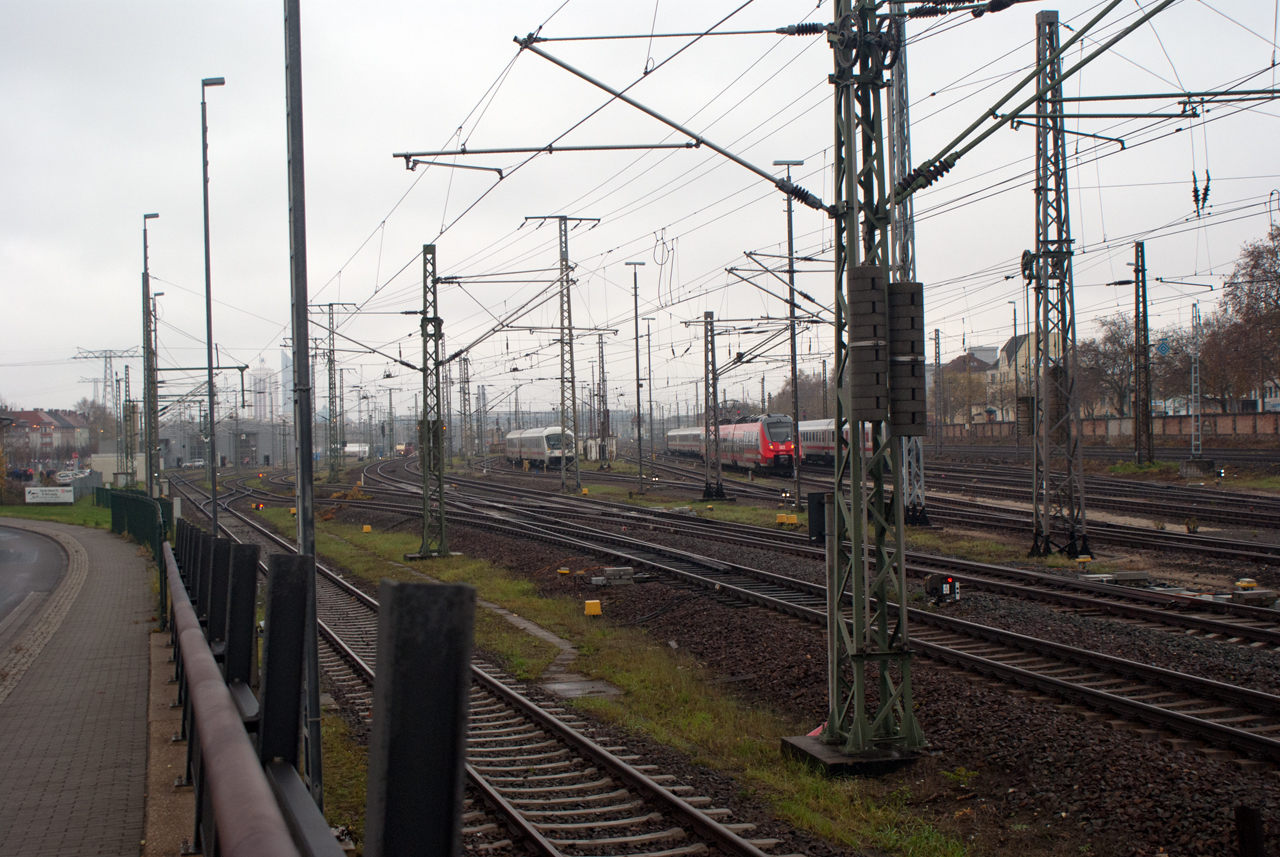
Coming from Berliner Brücke along Rackwitzer Straße and the northern track areas of the workshop grounds. The weather was unappealing, but that, of course, could not be helped.
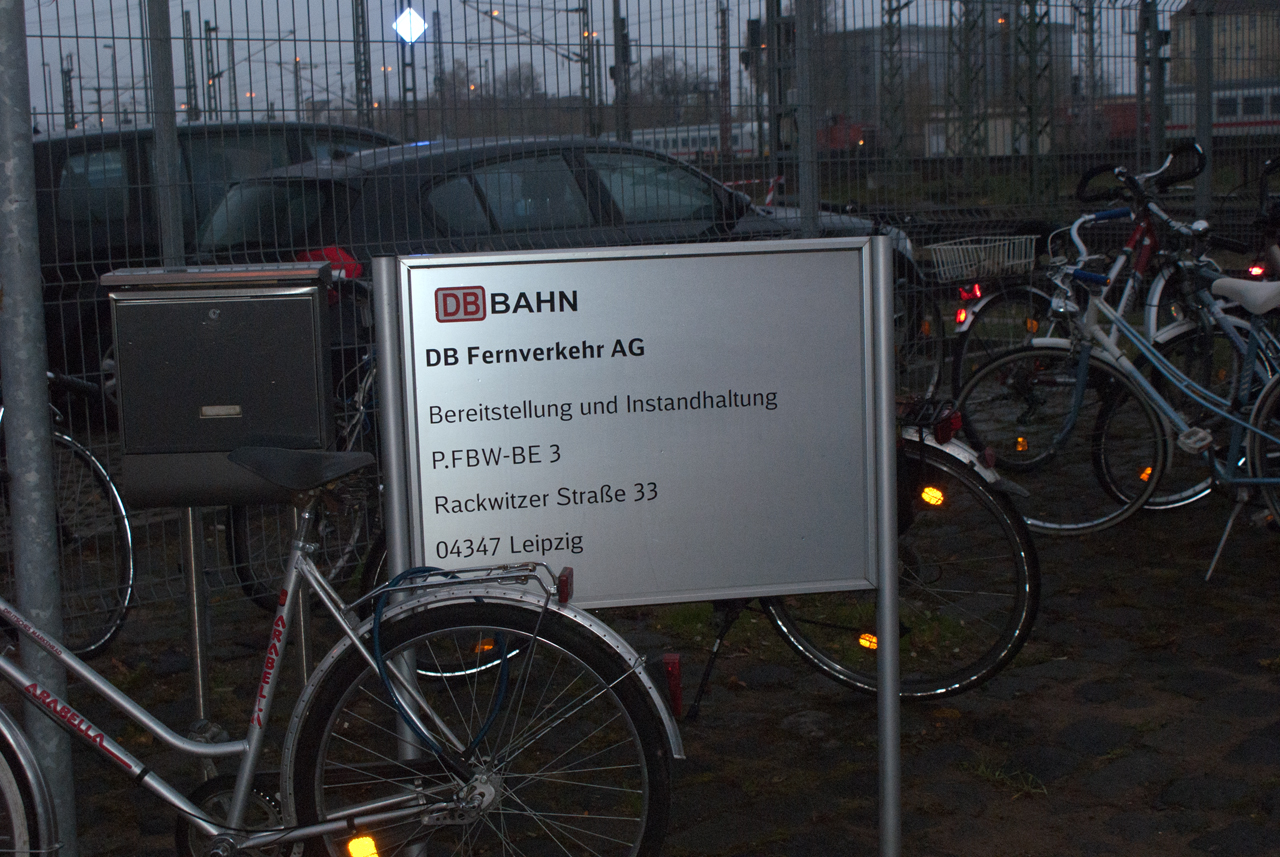
Gate sign.
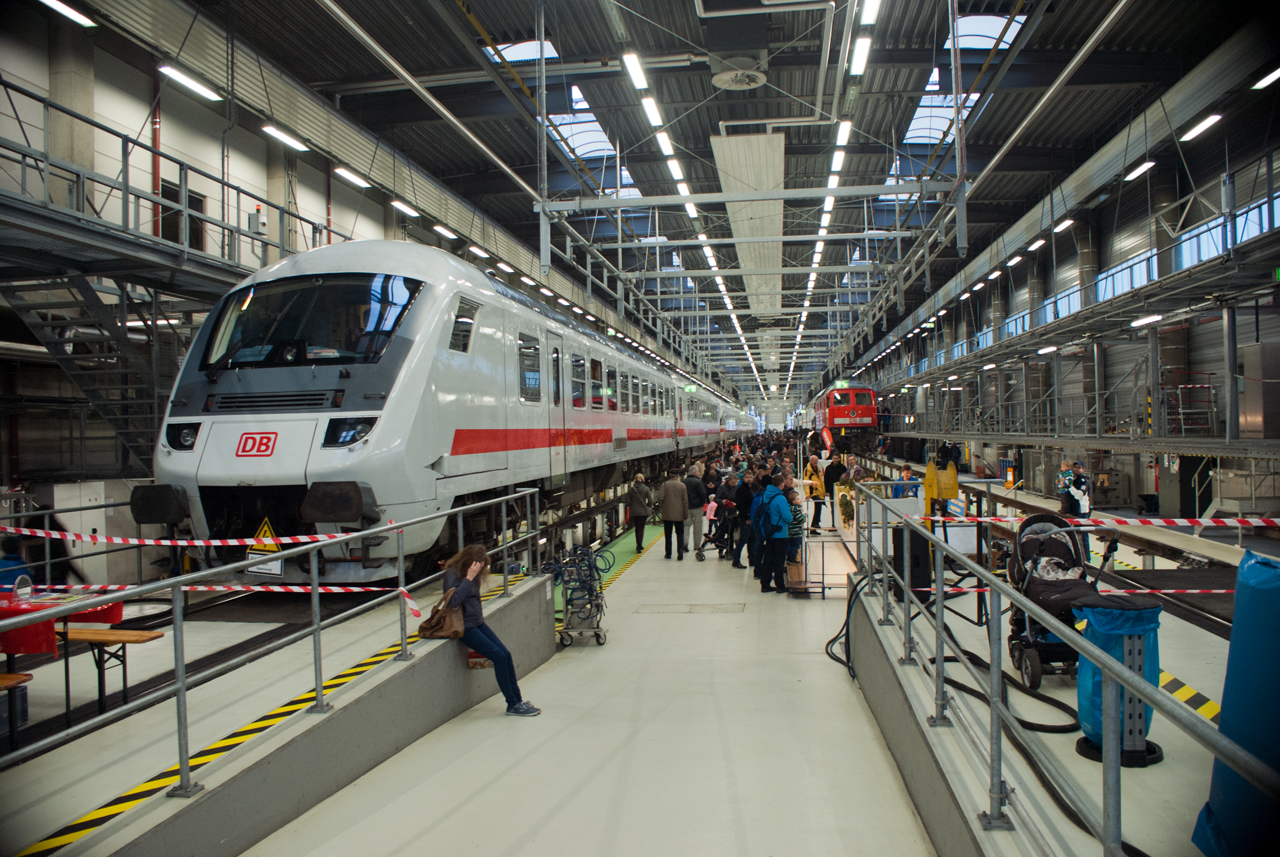
Overview of the maintenance shed where some 183 metres of track are trestled, roughly equalling the length of a class 411 ICE set consisting of seven cars and measuring 184.4 metres. The 415, consisting of five cars, is 132.6 metres long.
?The left track was occupied by a pair of standard IC coaches and ICE set 415 001 "Eisenach", while the other held the demonstrator formation of double deck IC stock with 146 564; 670 002, one of the seven class 670 double deck railbuses built for Deutsche Bahn in 1996 but returned to Bombardier in 2001 due to not having met all expectations; and 234 278, one of those class 232 diesels recertified for 140 kph and allocated to long distance services across the still-numerous non-electrified stretches which existed between former West and East Germany in the 1990s.

Underfloor and bogie details on the IC driving trailer…

…focusing on the PZB transceiver…

…and the magnetic track brake. These brakes are mandatory for speeds in excess of 140 kph because the braking forces required above this speed can, under German regulations, not be achieved solely by wheel and dynamic brakes.
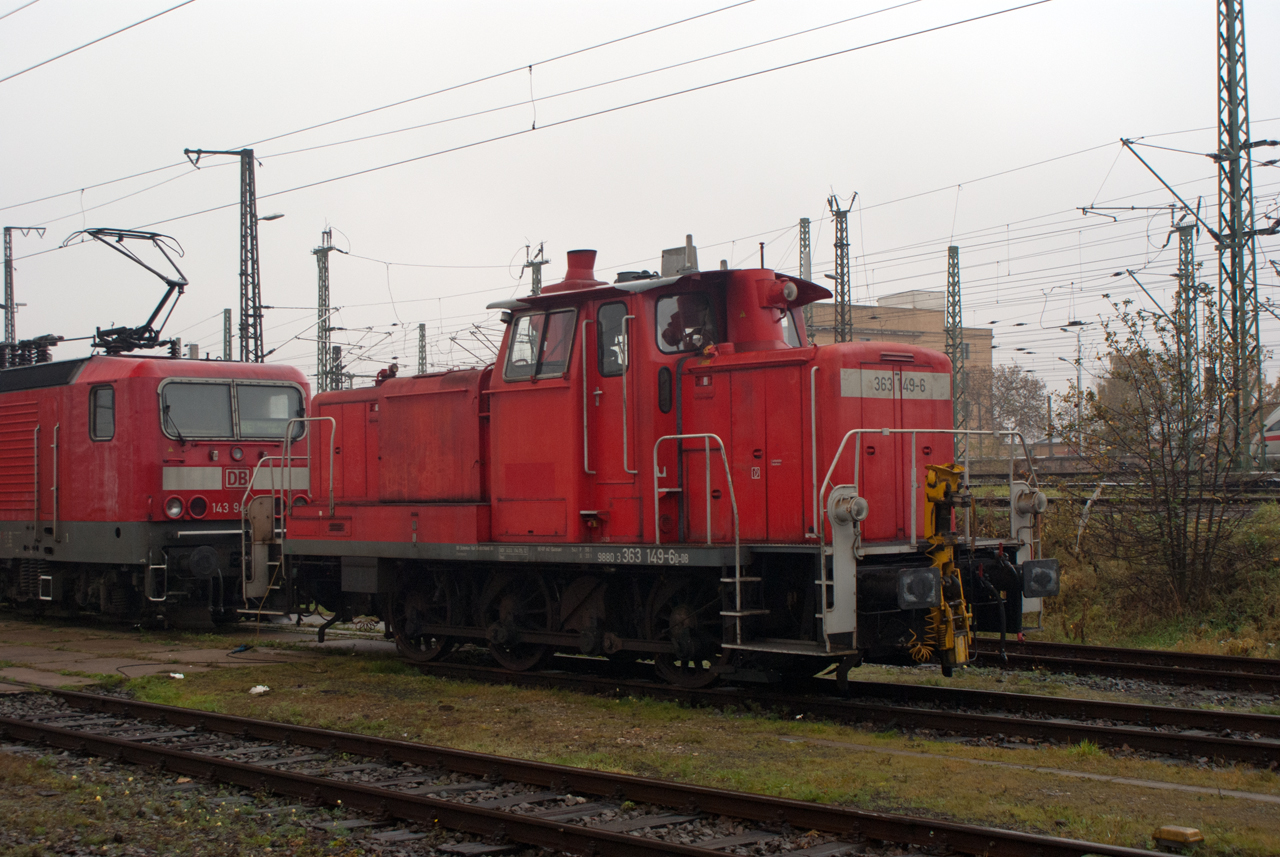
Outside, 363 149, one of the numerous ex-DB V 60 series shunters relocated to ex-Deutsche Reichsbahn territory, was sitting in the drizzle…

…together with 143 944.

Further back into the workshop grounds, BB 437026 of SNCF Fret/Akiem was stabled in a siding. It is not uncommon for freight locomotives, regardless of operator, to be stabled around Leipzig Central Station.

Not easily photographed due to the stabling arrangement in the workshop grounds, VT 18.16.03 represented one of the premier pieces of GDR-developed motive power. Taking many cues from the pre-war express DMU VT 137 155, designed by Franz Kruckenberg, the VT 18.16 was pitched as the equivalent to the West German VT 11.5 series diesel trains used for the prestigious Trans Europ Express services. With one 736 kW Johannisthal 12 KVD 18/21 prime mover in each power unit, these four-car diesel-hydraulic trains were capable of 160 kph.
The VT 18.16 sets worked the "Berlinaren" services from Berlin to Malmö; "Karlex" and "Karola" from Berlin and Leipzig to Karlsbad, "Neptun" from Berlin to Copenhagen; "Vindobona" from Berlin to Vienna via Prague; and Berlin-Bautzen. The Berlin-Malmö and Berlin-Copenhagen services used the Sassnitz-Trelleborg and Warnemünde-Gedser railway ferries respectively.
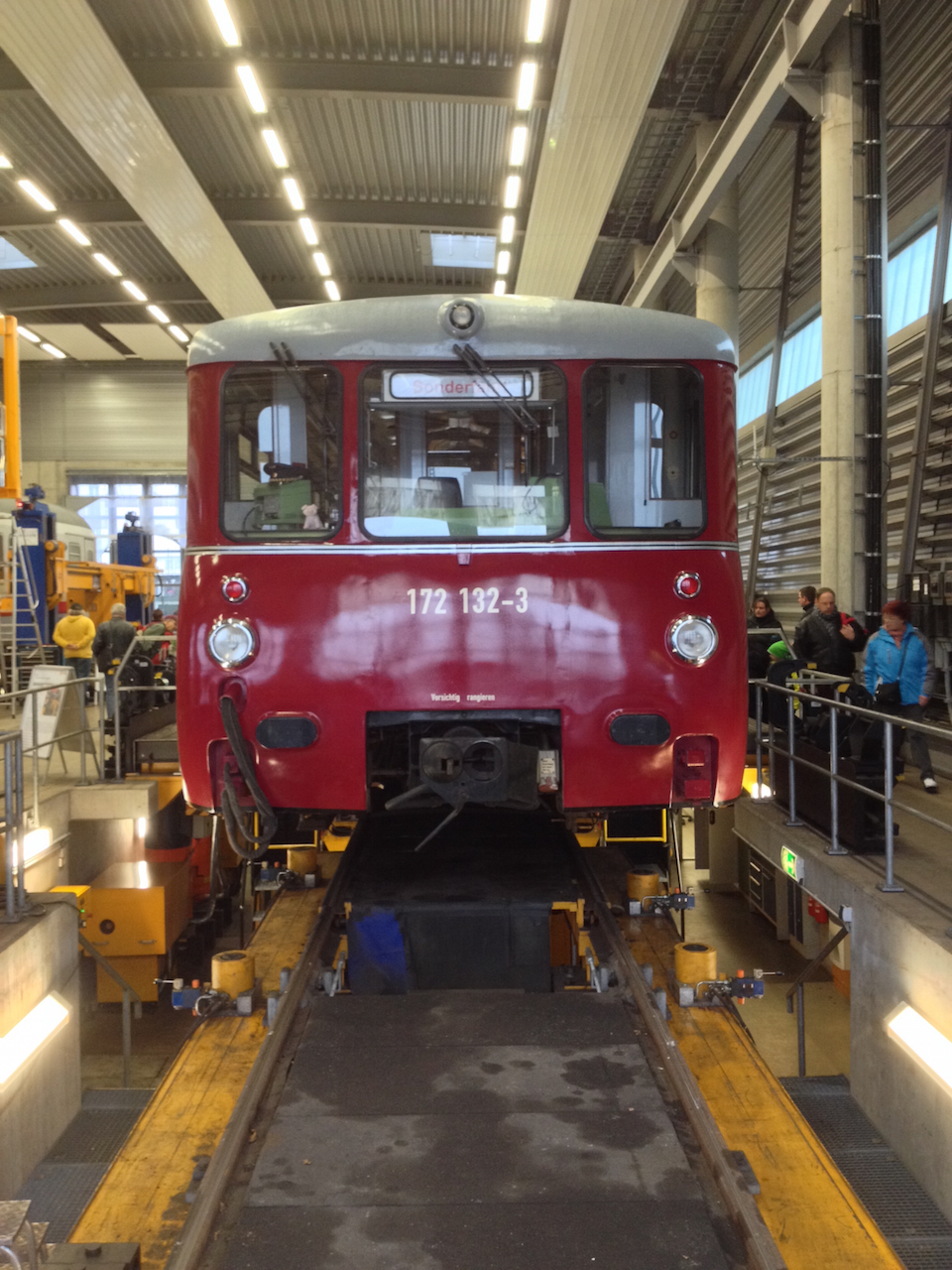
?The second maintenance shed on the workshop grounds contains a bogie maintenance and wheelset reprofiling unit. Here, DR railbus 172 132 is actually having its wheelsets reprofiled.
The double deck IC formation
In 2011, Deutsche Bahn ordered a batch of 27 five-car formations of double deck InterCity stock derived from the well-known Bombardier double deck stock. With this stock now being marketed under the "TWINDEXX" brand and also being offered in an EMU configuration with powered driving trailers, the IC formations were to consist of four all-2nd class coaches (one of these being the driving trailer) and one all-1st class coach. Certification issues resulted in the introduction of these formations to be pushed back to late 2015, though the class 146.5 locomotives earmarked for these services have been largely produced already.
With 27 locomotives ordered, the InterCity 146s will be numbered 146 551 through 577 and are largely identical to the 146.2s which have been in regional service for several years, but needed to be outfitted with some additional equipment specifically needed for the double deck IC stock.
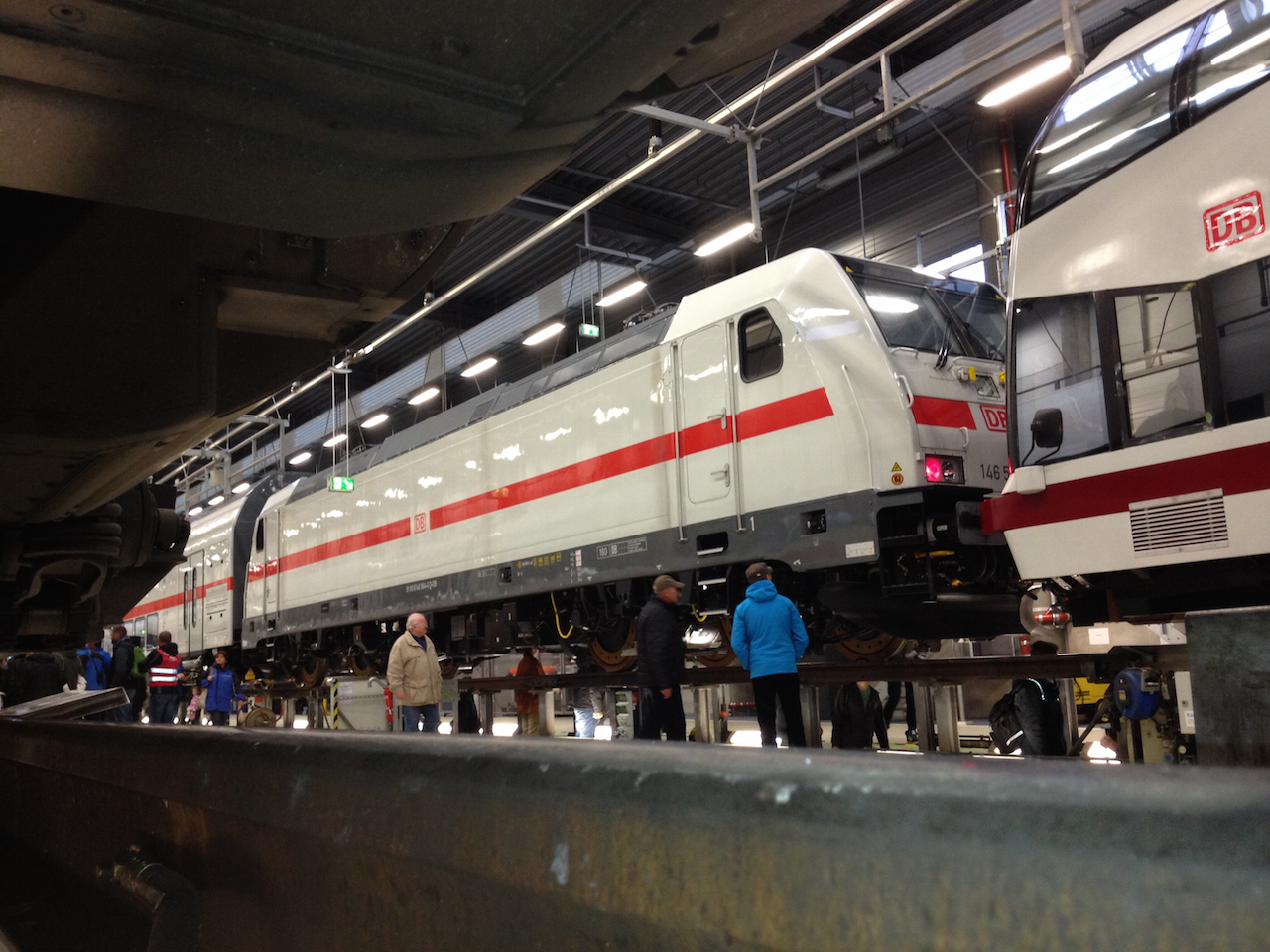
As the formation was blocked in between the shed gate and the 670, the only sensible location to get an impression of the locomotive was from the maintenance pit below the adjacent track! The locomotive on display was 146 564, works number 35041, delivered last year.
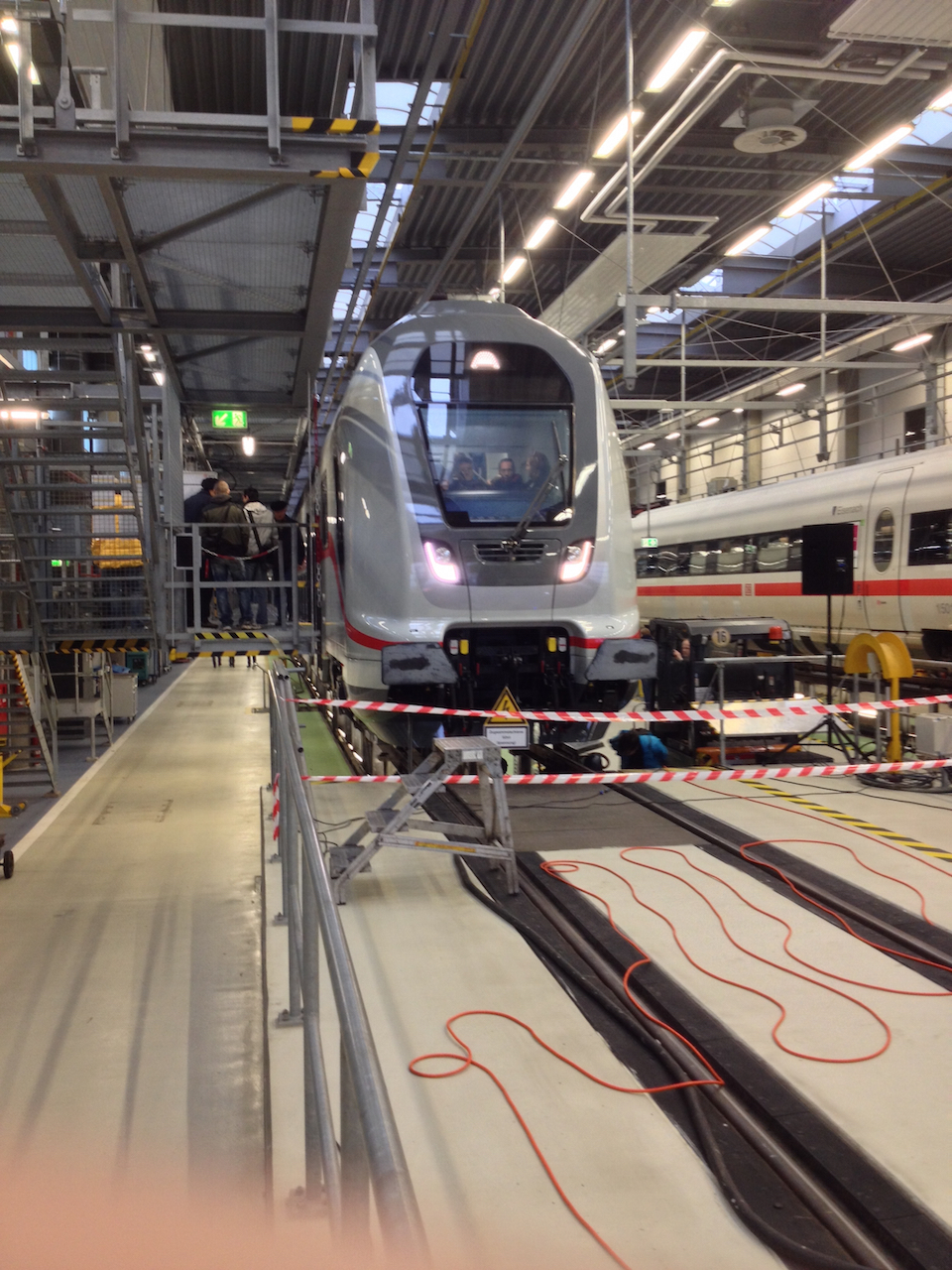
The cab face of the TWINDEXX driving trailers has been redesigned to also accommodate LED running lights. They can be outfitted with automatic couplers if so desired.
Bogie details on the coaches…
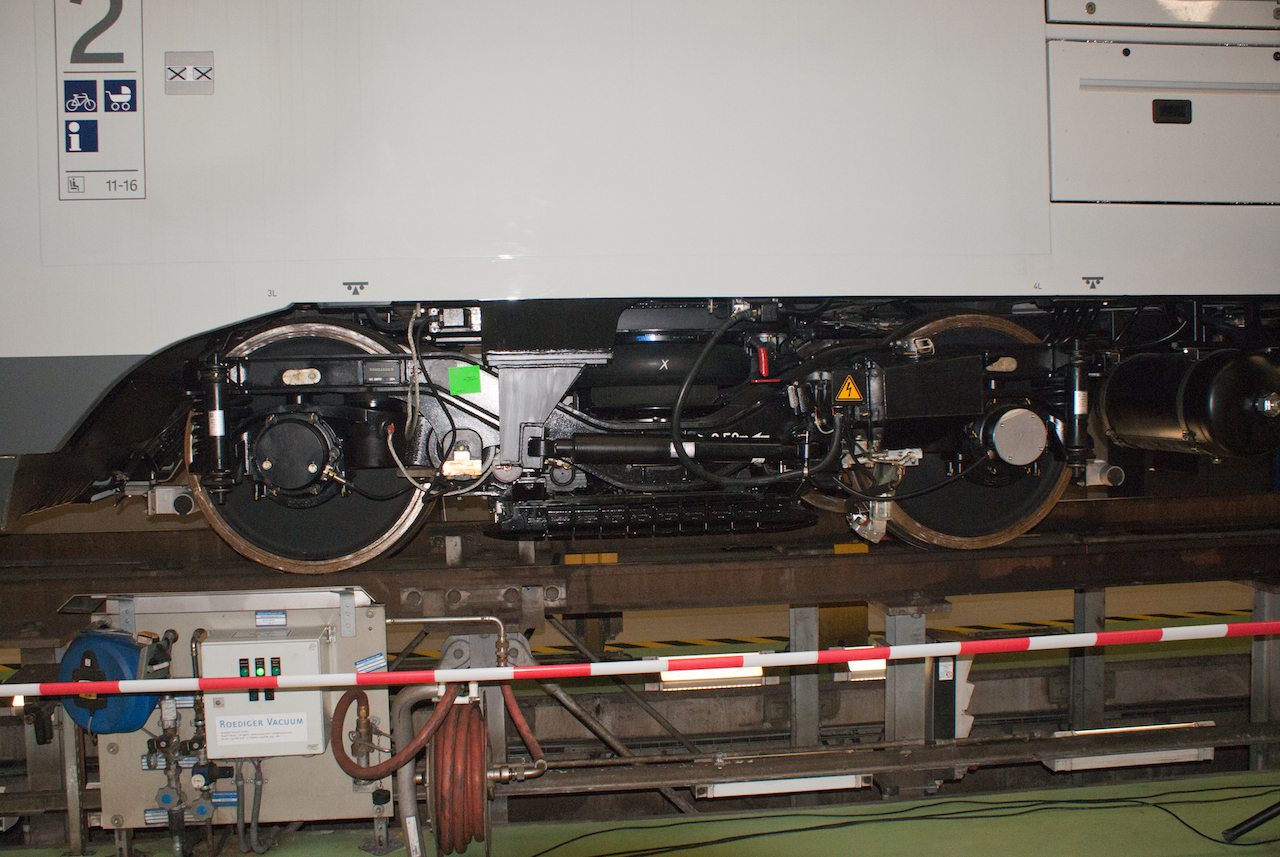
…this being the leading bogie on the driving trailer with the LZB pickup antennas being visible immediately outside the wheelsets. It was quite intriguing to see chassis details barely affected by dirt and wear!
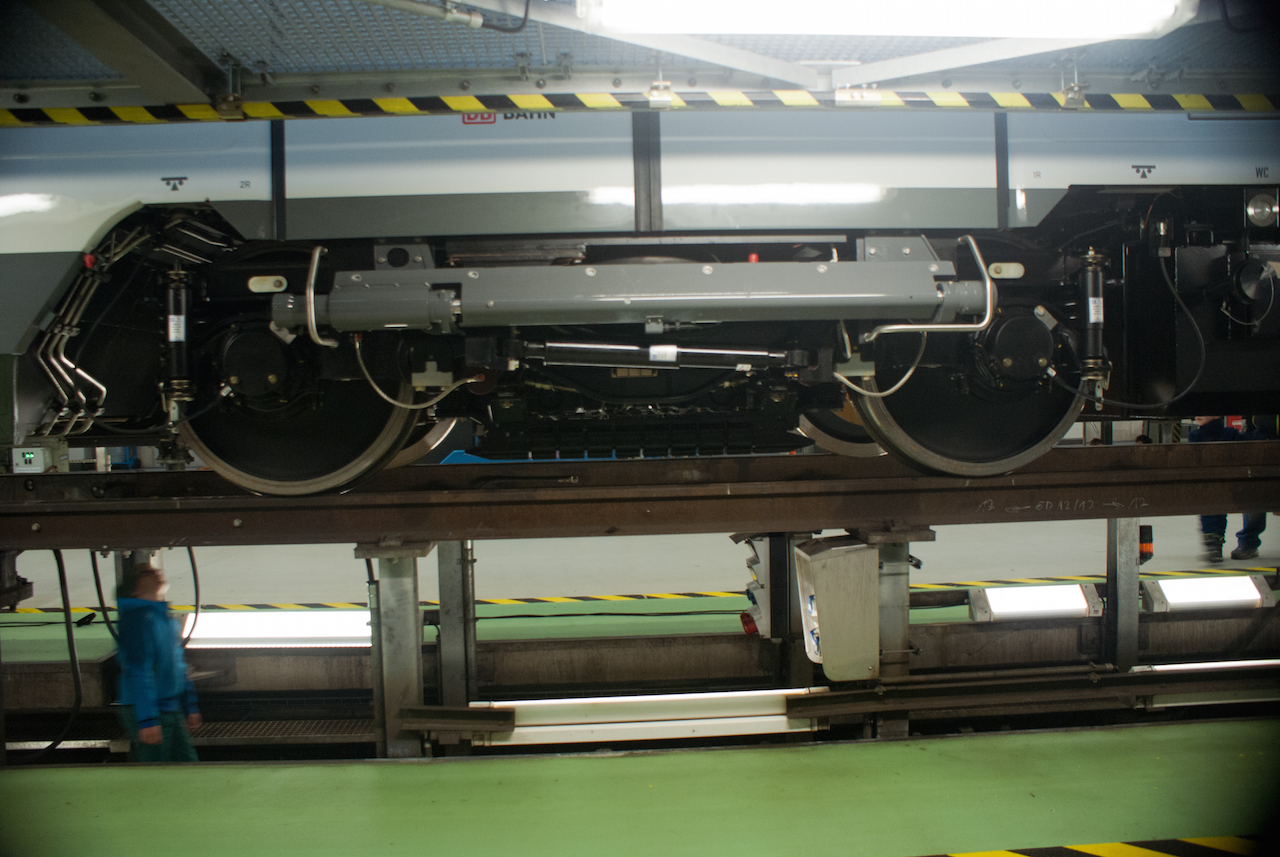
?Bogie on one of the intermediate coaches. The TWINDEXX driving trailers are generally provided with lower floor entrance while the intermediate coaches can be configured with mid-floor passenger doors above the bogies or on the lower deck. The intermediate IC coaches are of the mid-floor variety.
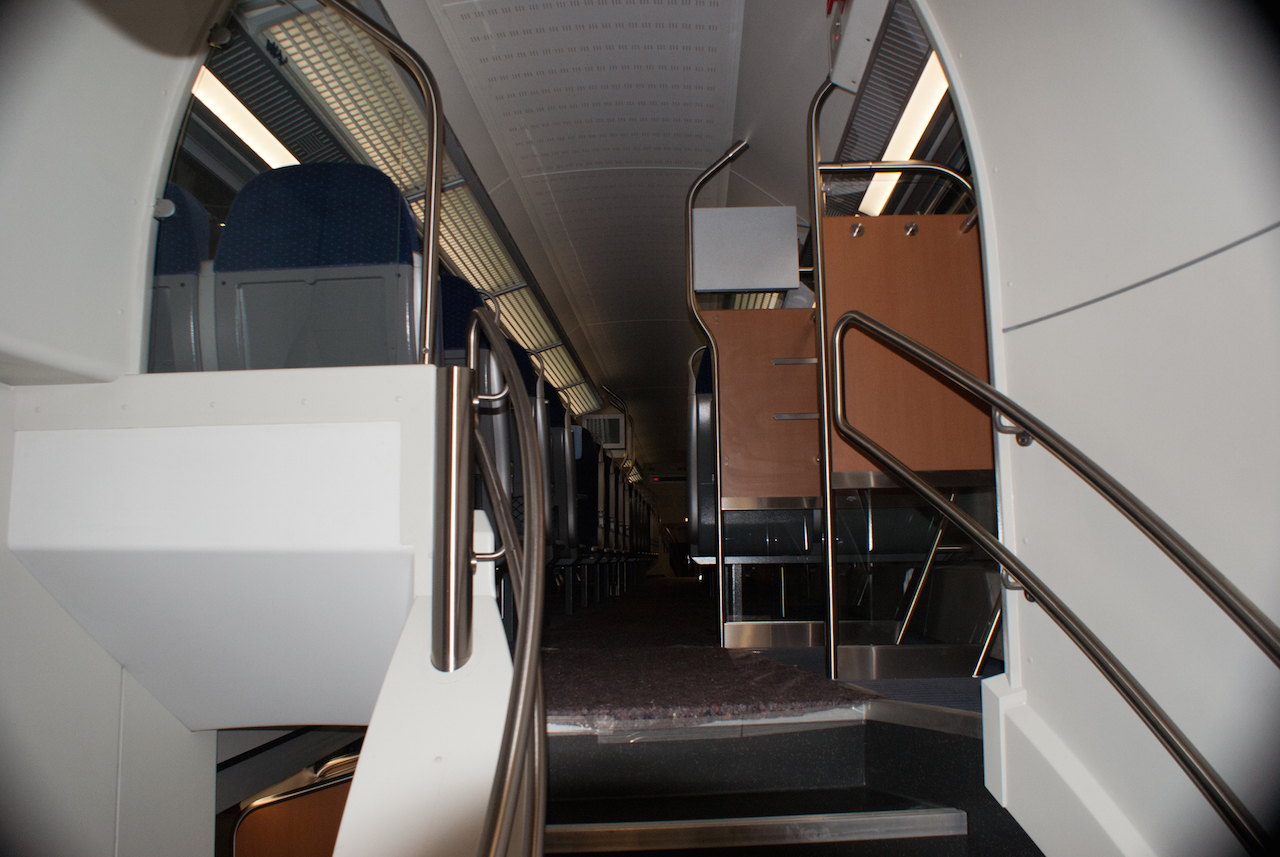
Interior stairwell. The chairs are not too different to those on regional double deck stock, though the interior as a whole is styled similar to the current appearance of the ICE formations.
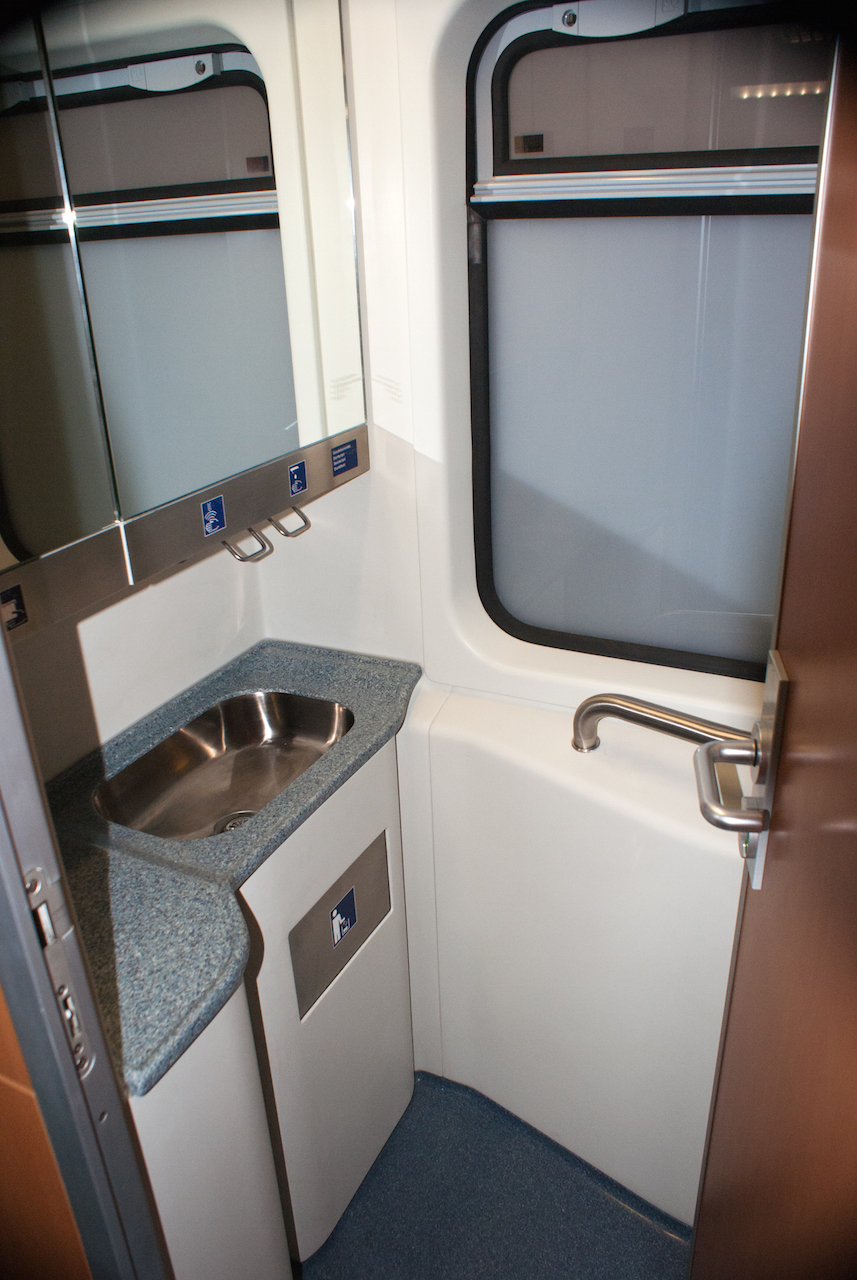
Lavatory…
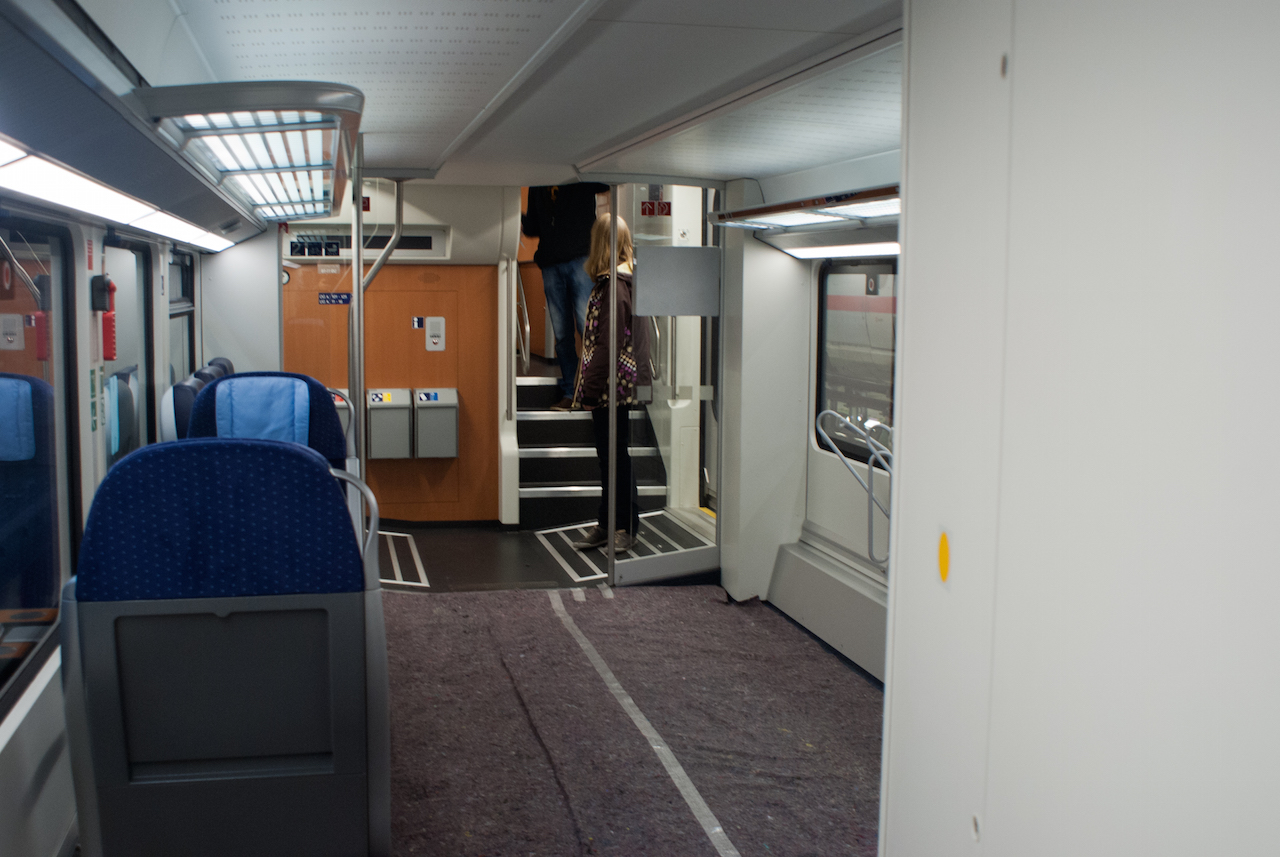
Lower deck – note the felt mats laid out to keep the coaches mint for as long as possible…
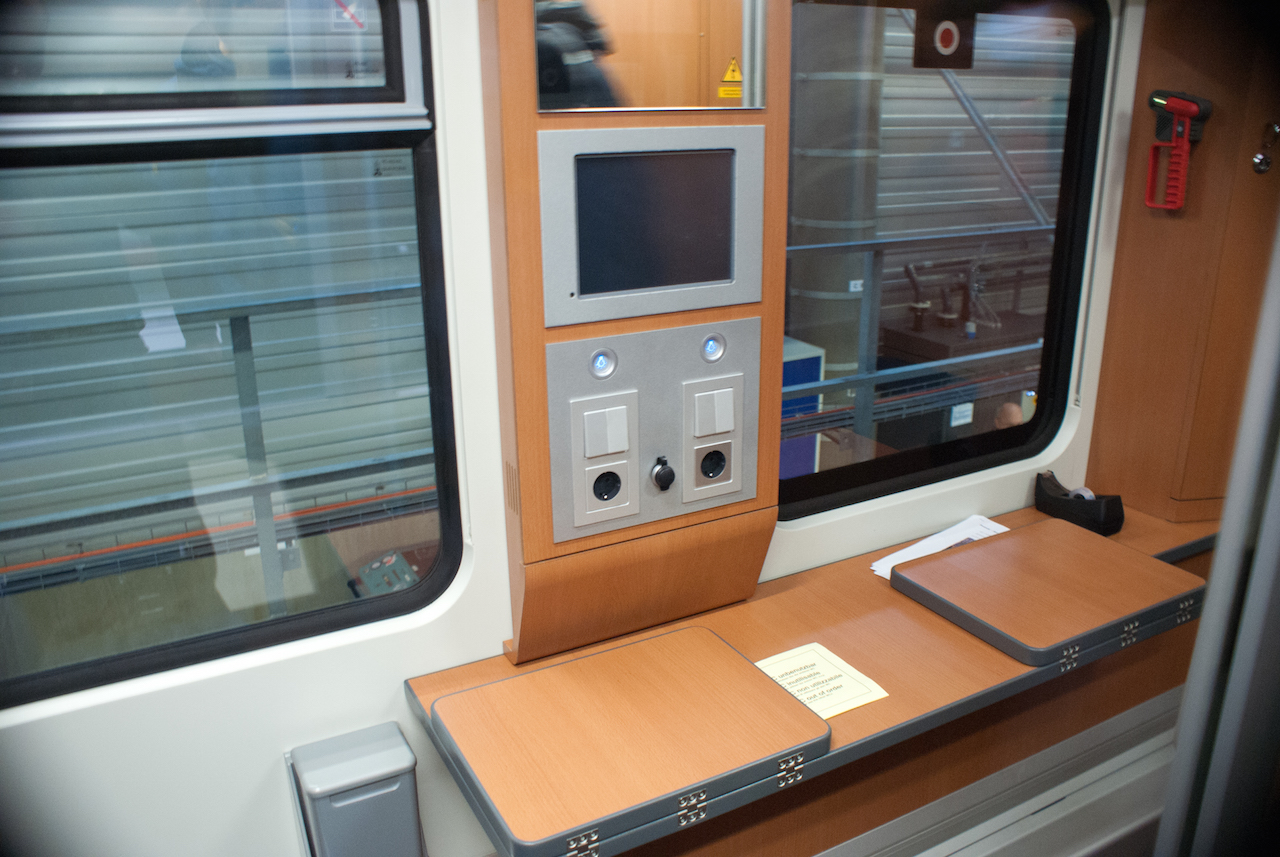
Office space.
Technical lettering on the coaches:

…translating into the following information:
High performance brake (<R>); unified Knorr brake (KE) with setting "R", automatic load adjustment (A) and magnetic track brake (Mg); disk brake ( (D) ); ECP equipped; emergency brake override fitted (NBÜ); braking weights: R+
Mg with brake application accelerator (red font) 116 t, R with brake application accelerator 84 t; R without brake application accelerator 79 t.
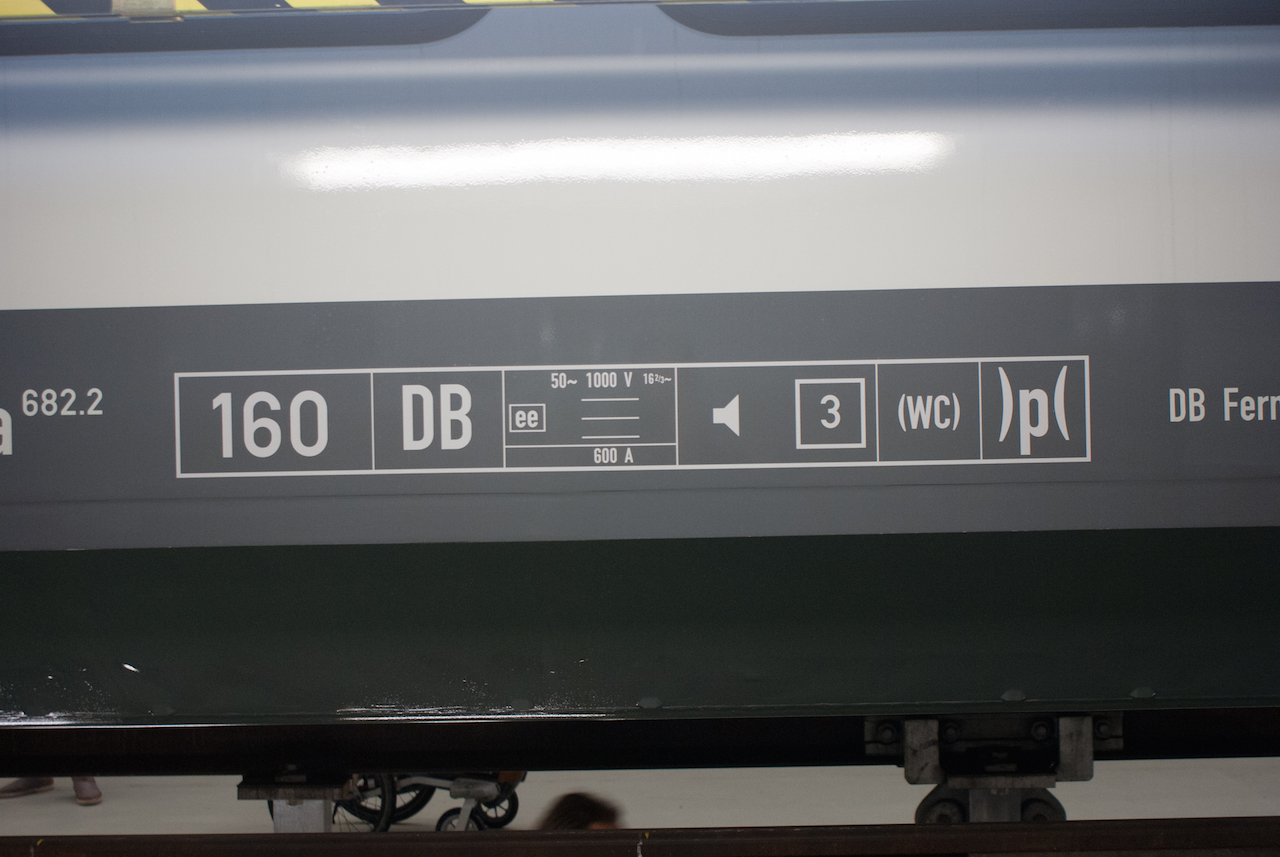
Maximum running speed of 160 kph; owned by Deutsche Bahn; ETS equipped for 1,000 V at 16 ? and 50 Hz and 600 A; Type 3 PA system; insulated lavatories; ECP door locking.
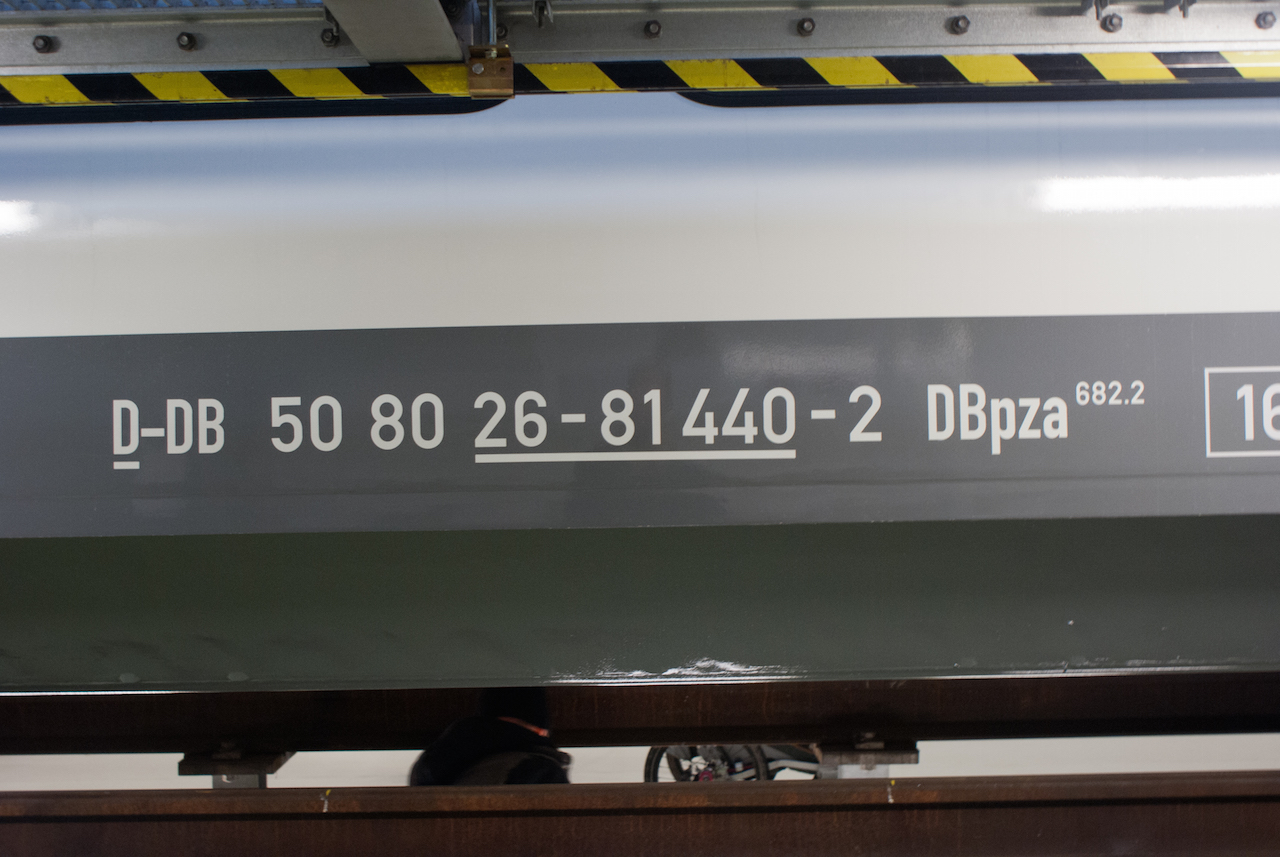
German coach owned by Deutsche Bahn; coach number: 50 (not RIC compliant) 80 (Germany) 26-81 440-2 (core running number); DBpza = double deck (D) second class ( B) coach with open seating and air conditioning ( p ), ETS power supply only (z); electronically safeguarded door locking for single-person operation (a).
As for the 1st class coach:
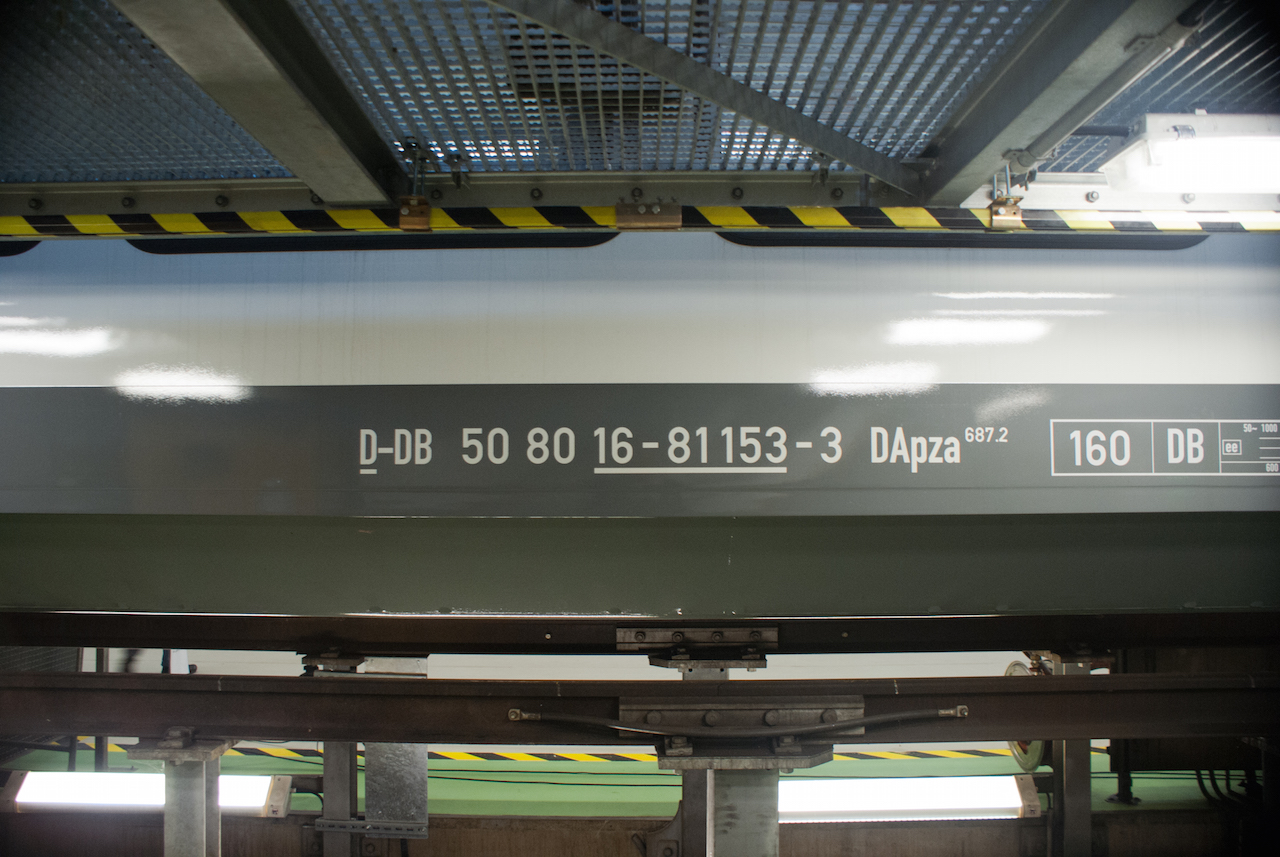
…and the driving trailer:
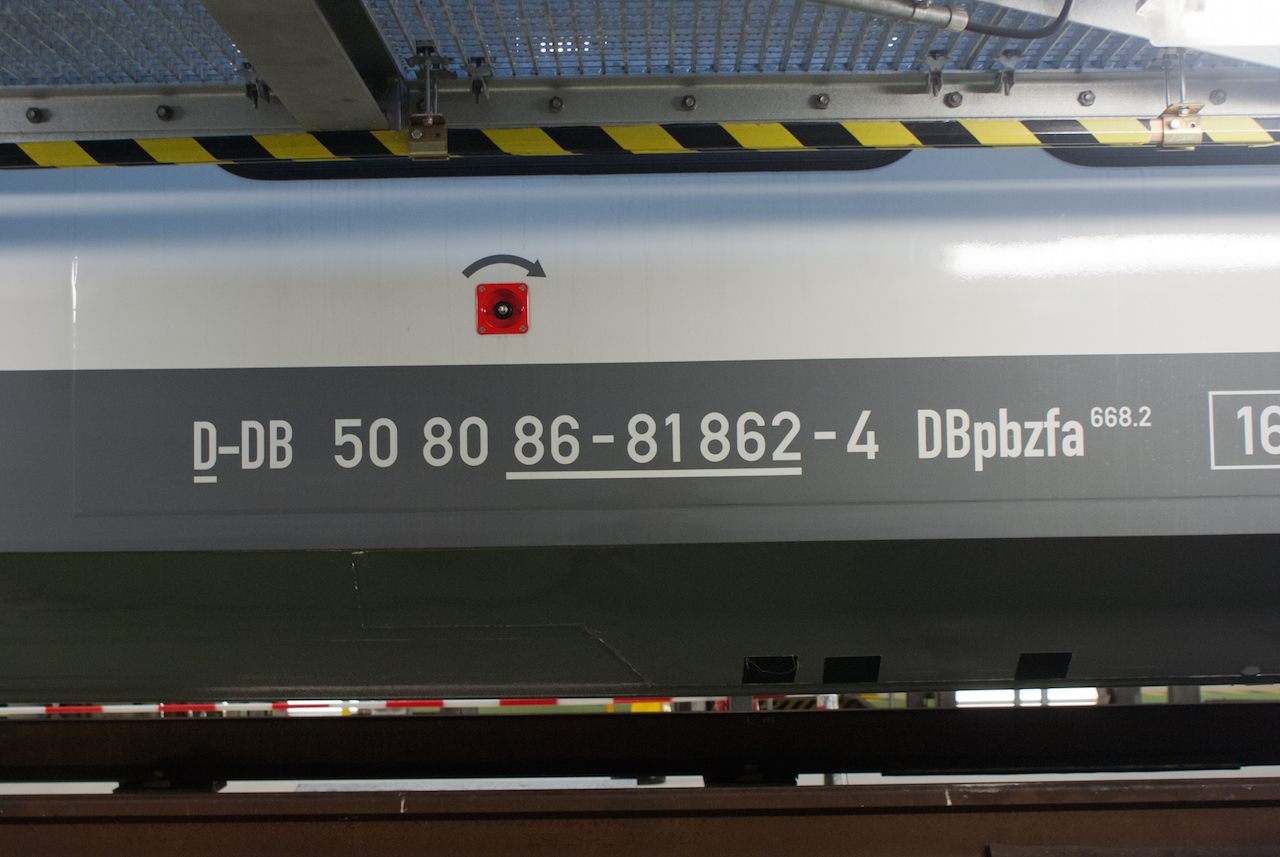
DBpbzfa translates into: double deck (D) second class ( B ) coach with open seating and air conditioning ( p ), accessibility provisions ( b ) ETS power supply only (z), driving trailer (f), electronically safeguarded door locking for single-person operation (a)
The superscripted numbers refer to subtypes of the coach category outlined by the letter block.
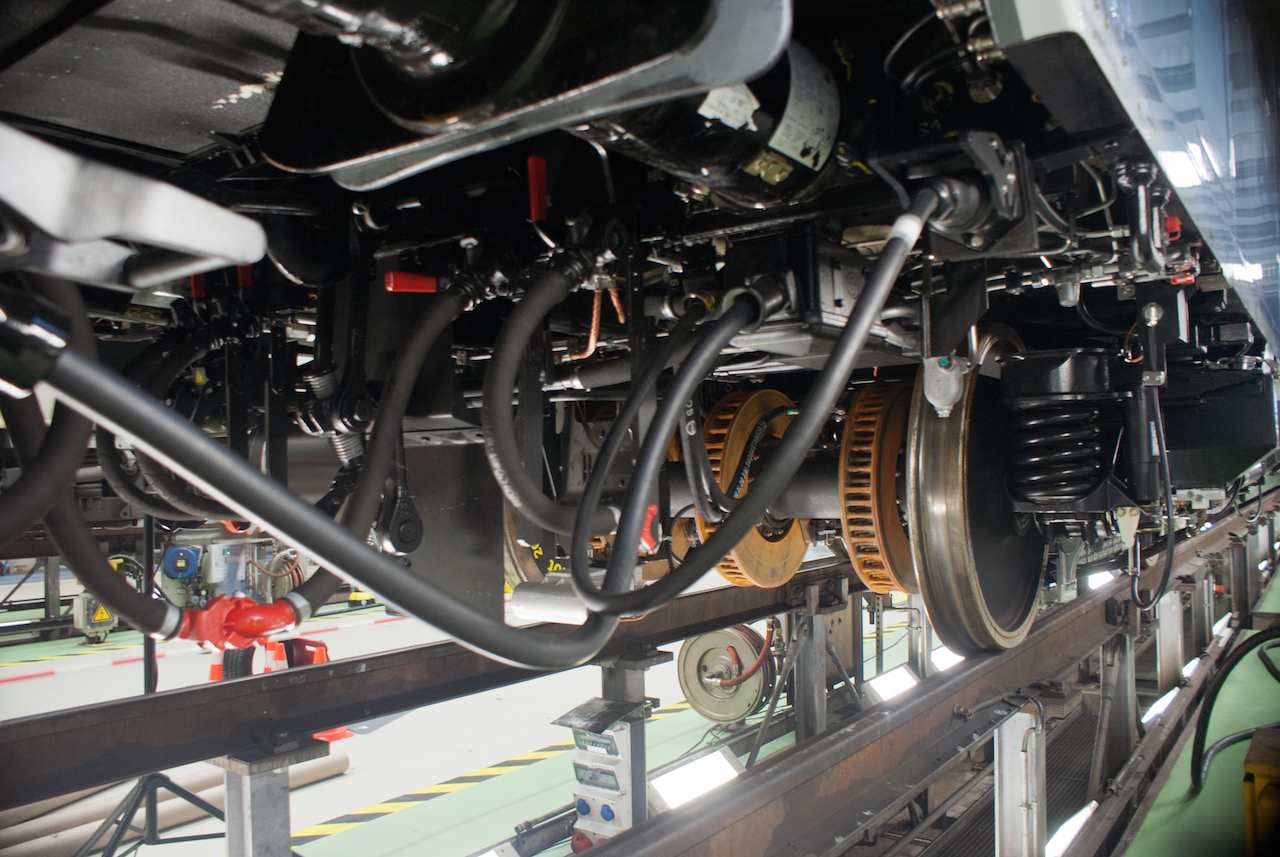
Extensive pipework and cabling, comprising brake pipes and ETS jumper cable. Also note the brake disks, of which there are three per wheelset.
Bogie and underfloor details on the 146:

?Traction motors are of the squirrel cage induction type and suspended at the bogie centre.
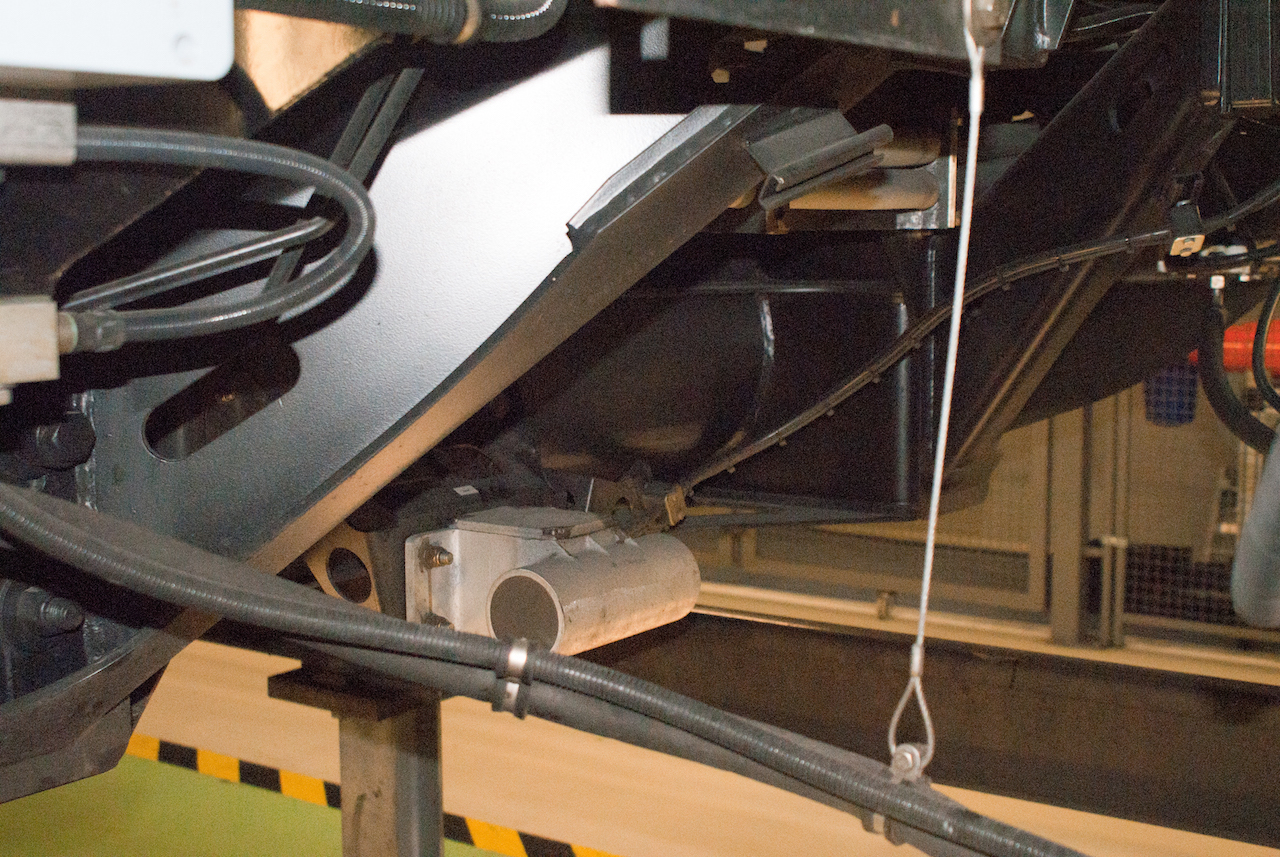
LZB antenna inside the snow plough…

…and PZB transceiver.
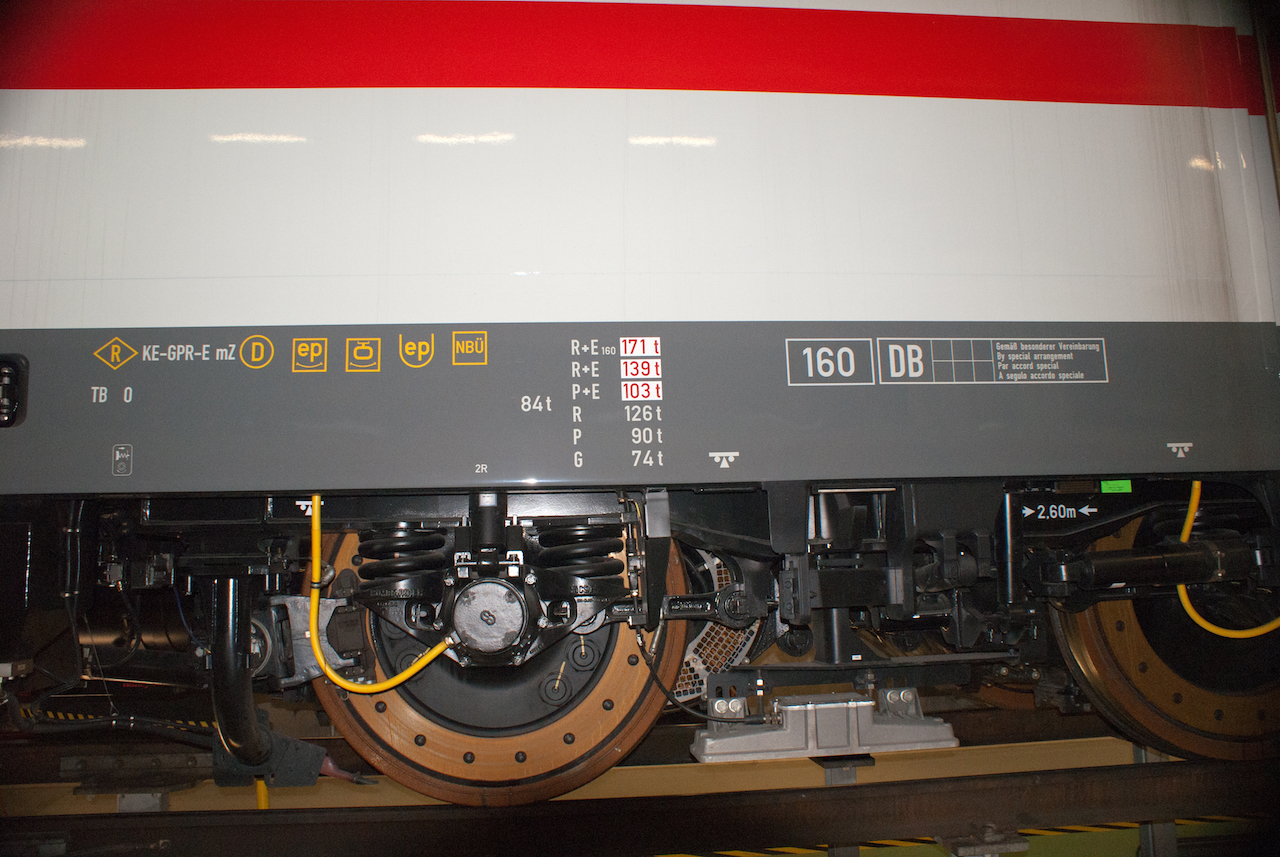
?Braking equipment; transmission bolts from the quill drive clearly visible, too. Technical lettering should be largely comprehensible now, though I should like to point out that the 146.5 is outfitted both for the domestic and the UIC standards for ECP and emergency brake override controls, explaining the seemingly duplicate lettering.
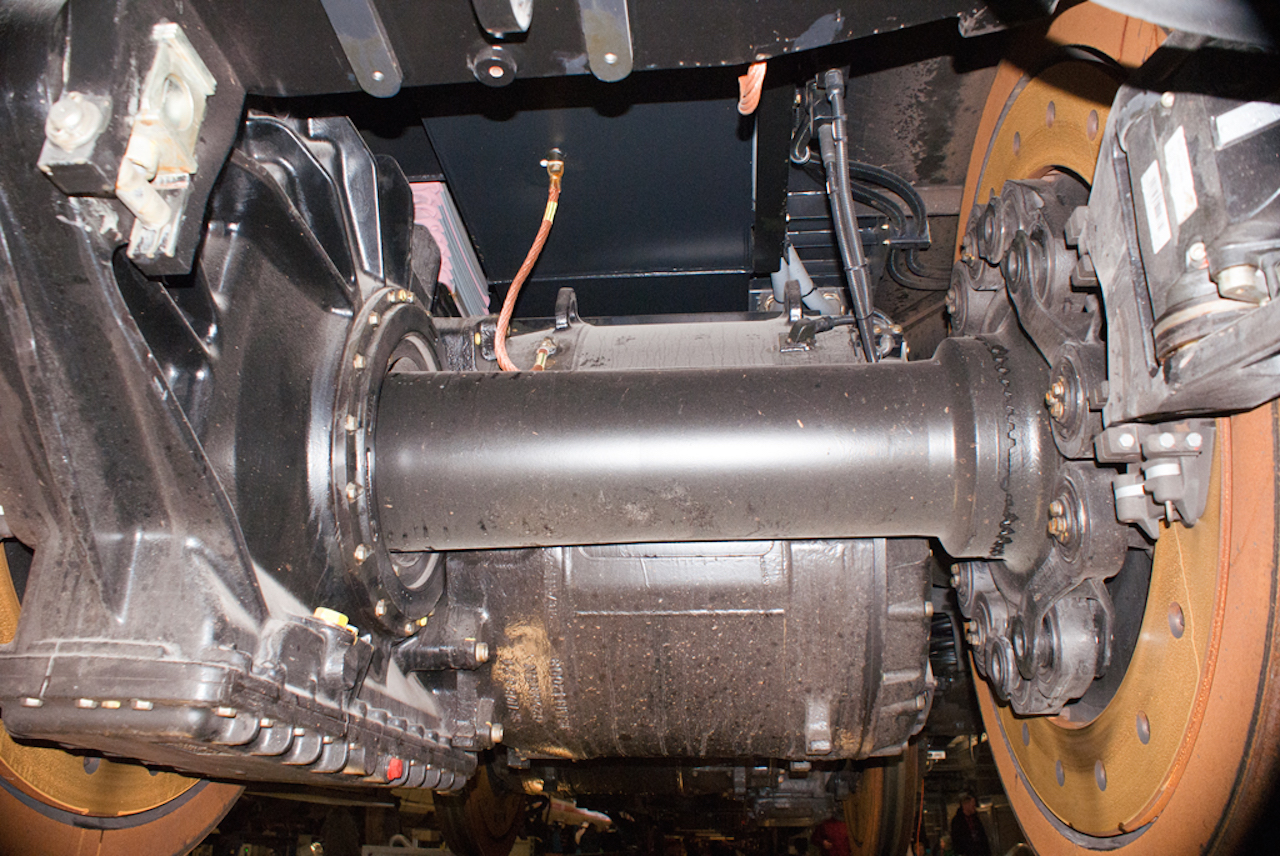
Wheelset gear (left), traction motor (centre, background), quill and wheel shaft (centre, foreground) and elastic transmission ring with transmission bolts (right).

Traction bar pivot bearing.
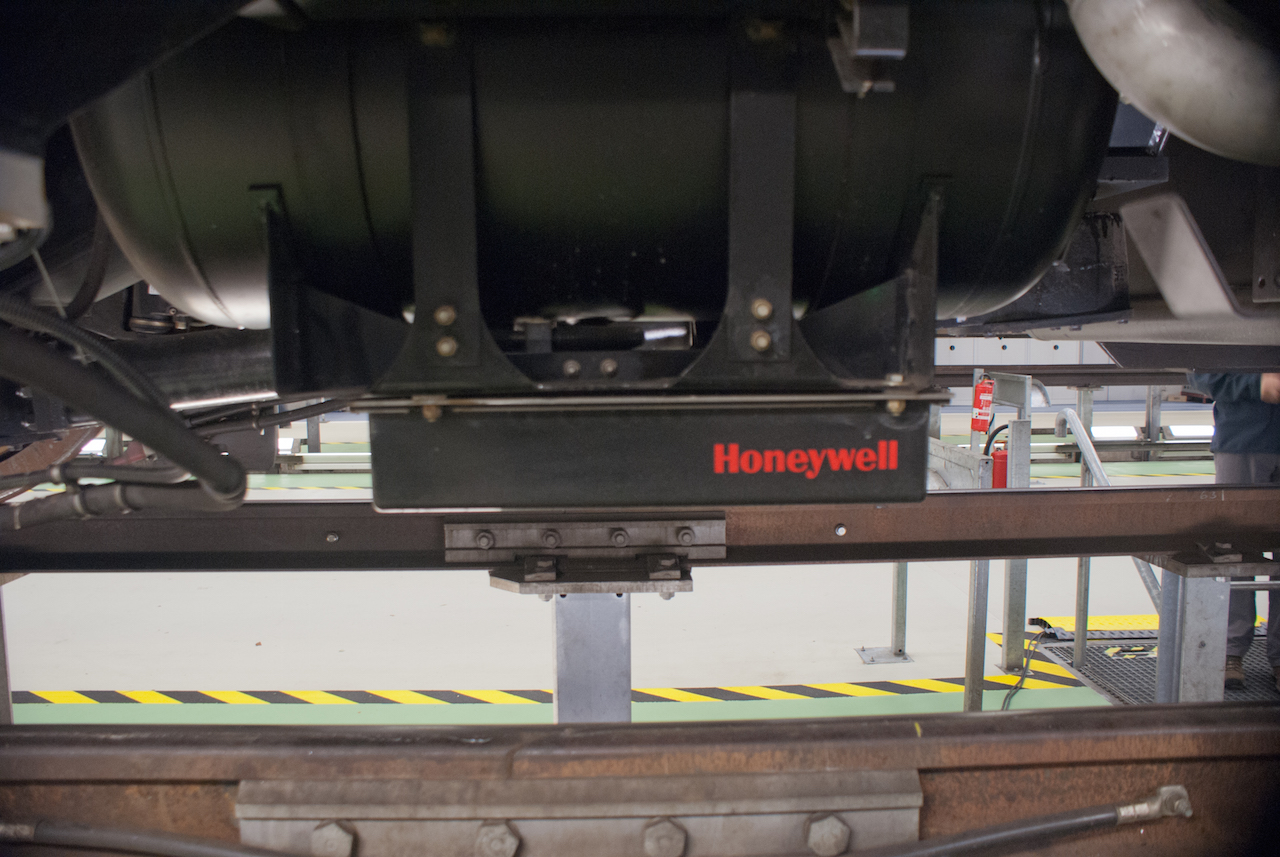
Radar speed sensor provided by Honeywell.

?The only real place to be on a locomotive! Seating is quite comfortable. The three TFT displays can be variably configured for failure resistance, though the centre one is normally used for speed, tractive effort and train protection indications. The left screen is most commonly used for diagnostic information, and the right one for the electronic working timetable.
The pair of controller levers positioned for the driver's left hand are for speed control (AFB – left) and tractive effort (right); those positioned for the right hand are train brake (left) and dynamic brake (right). The two braking circuits can be independently controlled through unlocking the brake levers but are blended by default. The smaller "joystick" controller further to the right is for the direct brake.
The radio is located left of the power/speed controllers, while the field of switches below is for ventilation, pantograph and circuit breaker, and the vigilance, release and override keys for the train protection systems.
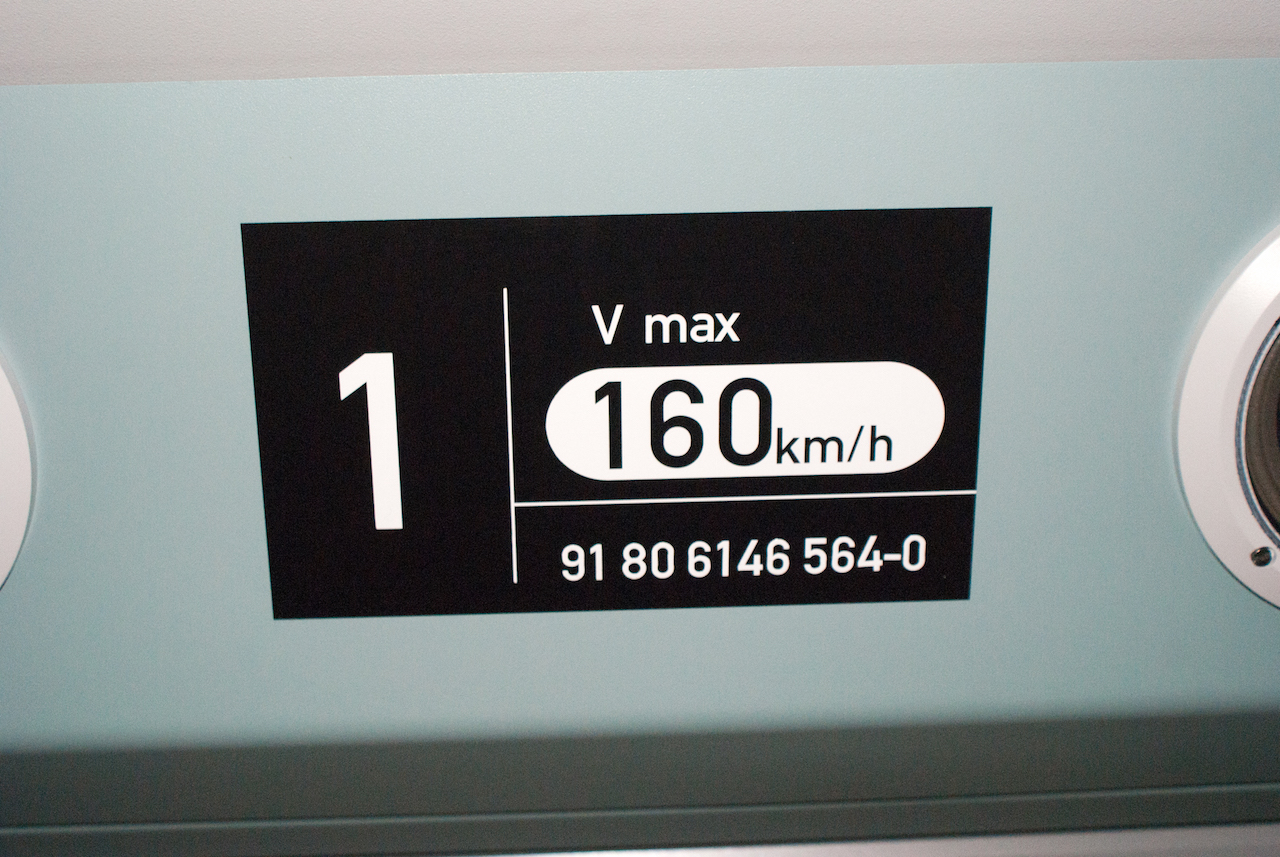
Just a reminder!

The 146.5s (and the additional batch of 146.2s also ordered for DB Regio) are now outfitted with two pairs of cable sockets for the standard UIC jumper cable and the Wire Train Bus cable.
Sovietskiy Teplovoz: 234 278
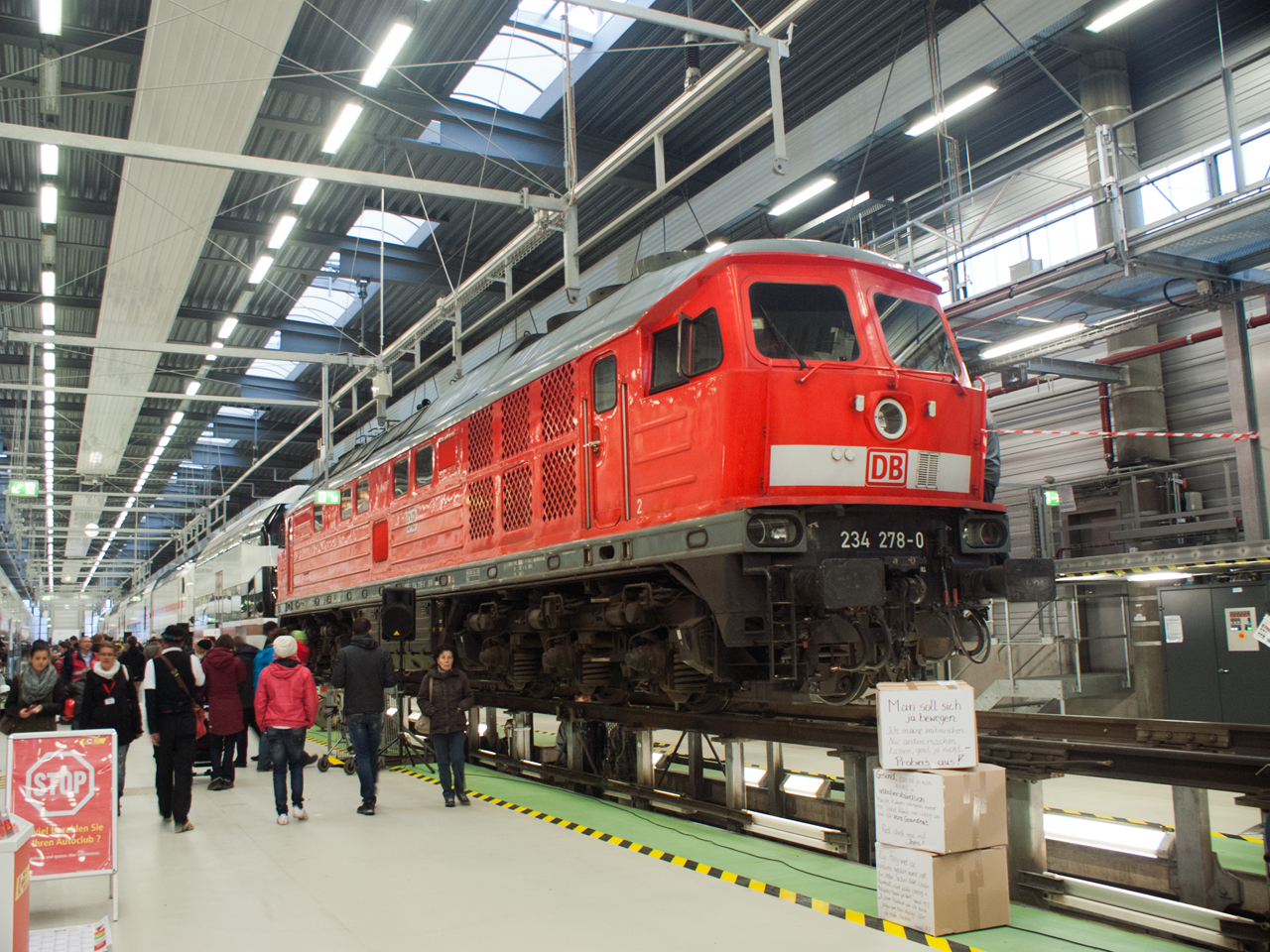
An imposing appearance, 234 278, works number 0491, was built and delivered to Deutsche Reichsbahn as 132 278 in 1975. Shortly after the adoption of ex-DB style running numbers, the locomotive was recertified for 140 kph and thus designated 234 278 on 27 May, 1992. Having been deactivated and stored from 24 November, 2007 till October 2009, the locomotive has been reactivated and is allocated to DB Fernverkehr.
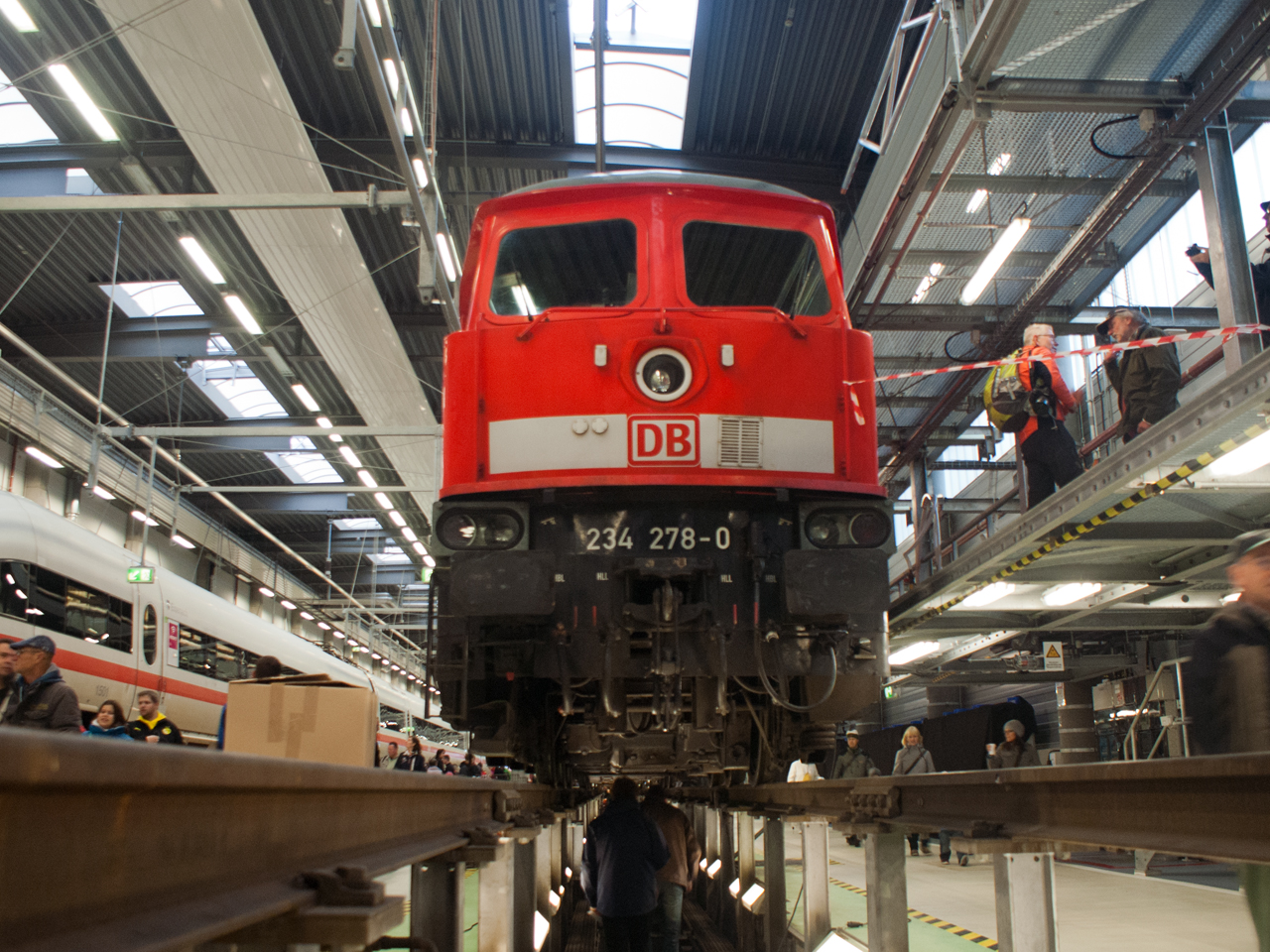
Viewed from the maintenance pit. And that, children, is why you should not even begin trespassing…

With the exception of the train radio, train protection unit and electronic timetable display unit, everything on the 234 is simple and straightforward technology which can probably be fixed with only a Swiss Army knife if required! Note that 234 278 is one of those twenty-three 234s outfitted for multiple working and push-pull controls.
The power controller is offset slightly to the left of the driver's position. The cab itself is somewhat on the cramped side of the spectrum, but the seat at least is sufficiently comfortable.
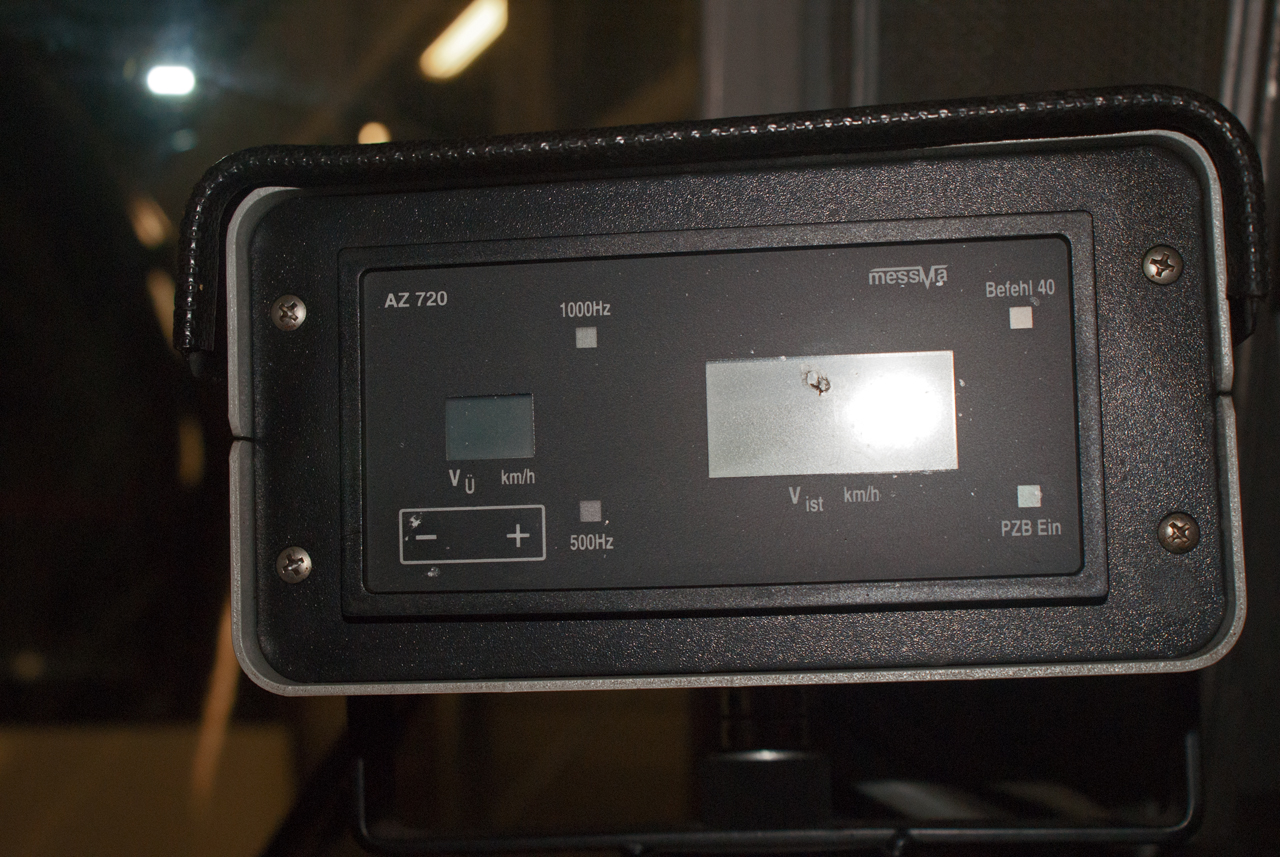
This is the cab display unit for the GDR-developed PZ 80 system, which in my personal opinion actually was superior to contemporary West German systems.
While this system is entirely compatible to the standardised German trackside train protection equipment with 500, 1,000 and 2,000 Hz RLC circuits, the PZ 80 system as built was quite different to the West German Indusi, or PZB, onboard devices. Train speeds could be entered in 10-kph steps from 50 to 160 kph – referred to as "Programmes 5 through 16" in Deutsche Reichsbahn terminology – rather than just three speed ranges calibrated to 95, 75 and 60 kph as on the West German devices. This means that the braking curves for speed monitoring could be calculated in the same number of intervals, and thus better matched a train's characteristics.
The PZ 80 system also offered a shunting mode which enabled shunting at a maximum speed of 40 kph without having to acknowledge any Indusi trackside circuits; and a permissive mode which in cases such as failed signals allowed proceeding at up to 50 kph in daylight and 15 kph at night without having to observe Indusi checks.
However, those locomotives outfitted with PZ 80 onboard devices were reprogrammed with an adapted version of the now-required PZB 90 software, emulating the same fundamental functionality as the former West German onboard devices. In this configuration, the system is also referred to as PZ 80R.
The PZ 80 cab unit also doubles as the locomotive's speedometer, which is what the larger of the two LCD displays is there for.
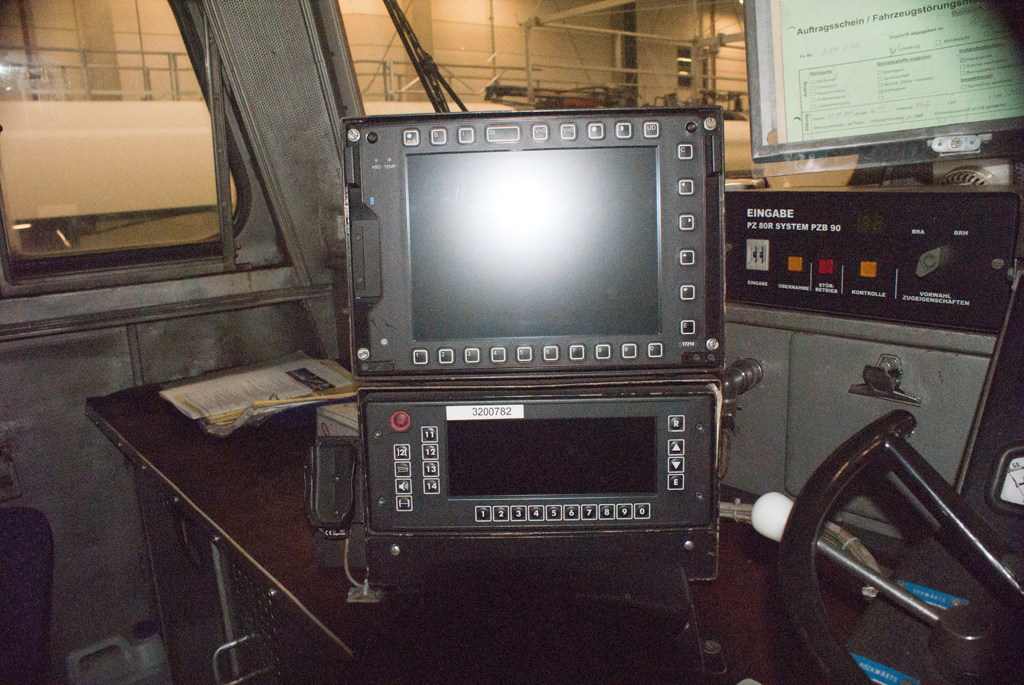
These are the electronic working timetable display unit (top) and radio (bottom). The electronic working timetable devices – also known as "EBuLa" – have been running on proprietary embedded versions of either Windows 95, Windows NT or Windows XP.
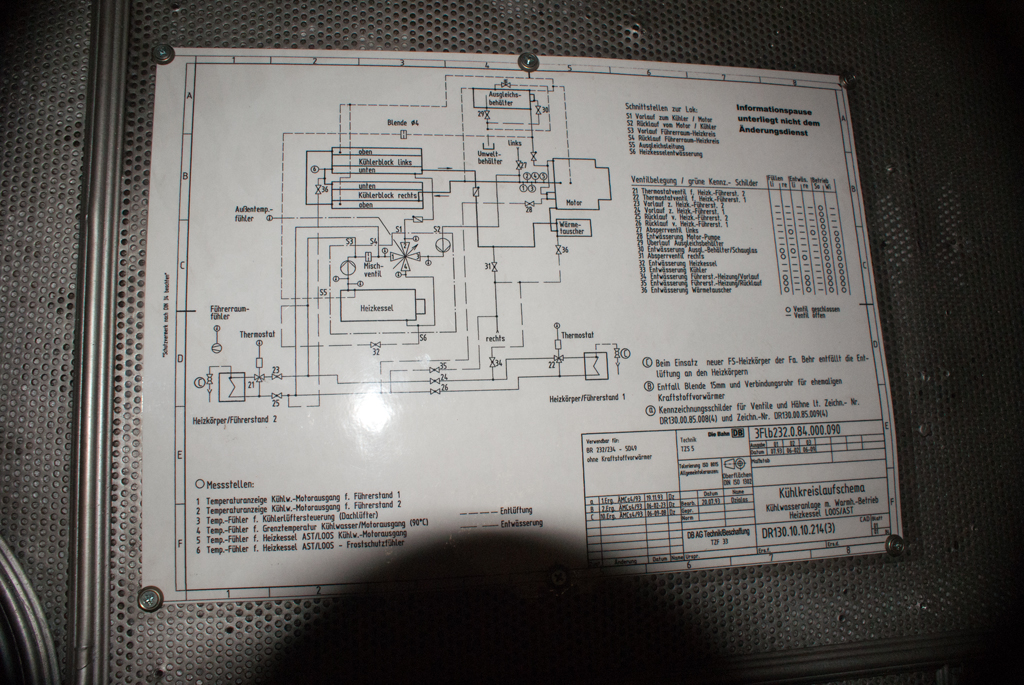
Radiator circuit diagram.

Bogie viewed from the maintenance pit.
ICE, Evolved: Class 407 EMU
As a follow-up to their fleet of Siemens-built class 403 (domestic only) and 406 (multi system units also certified for France, Belgium and the Netherlands) EMUs, also referred to as the "ICE 3" type, or "ICE 3M" for the 406, Deutsche Bahn ordered seventeen class 407 units in November 2008. Derived from the Siemens Velaro series, these units are multi-system capable. As, once again, technical issues caused significant certification delays, the first 407s could enter revenue service in late 2013.
These eight-car units are 200.72 m long, provide a duration power output of 8,000 kW, and a maximum speed of 320 kph.

407 002 was put on display on the workshop grounds to showcase the newest generation of ICE units.
Passenger spaces:

1st class…
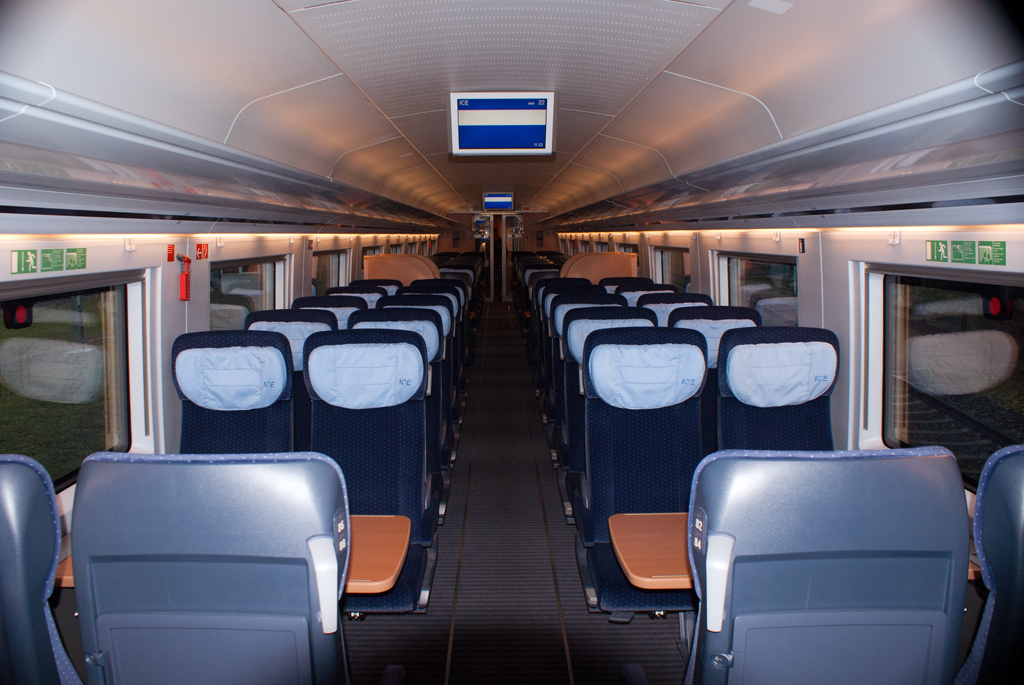
2nd class.
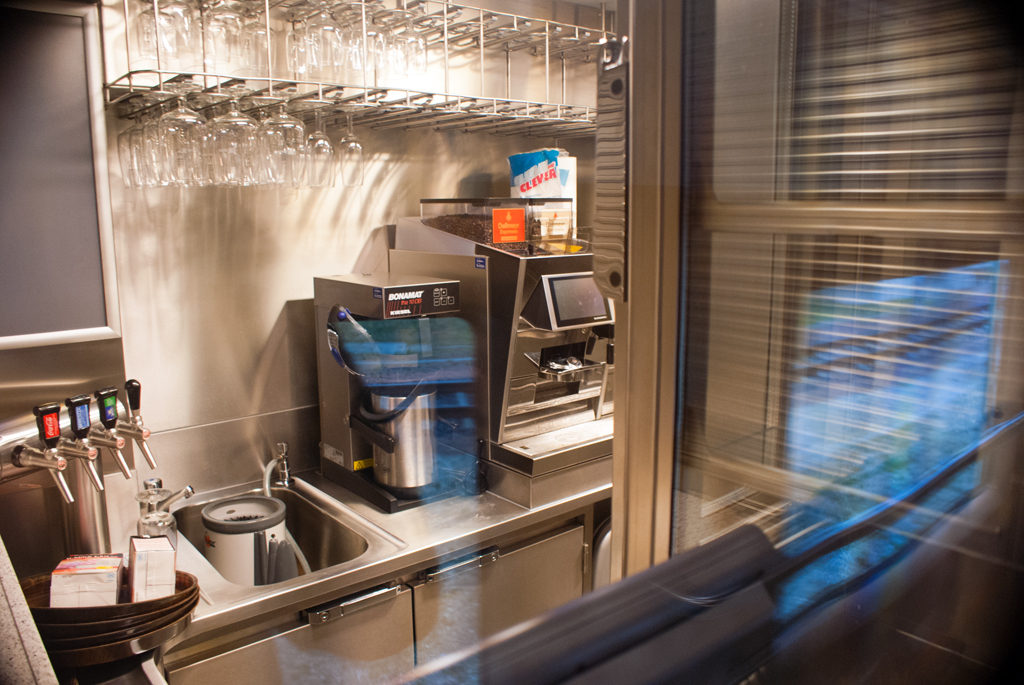
Galley in the Bistro coach…
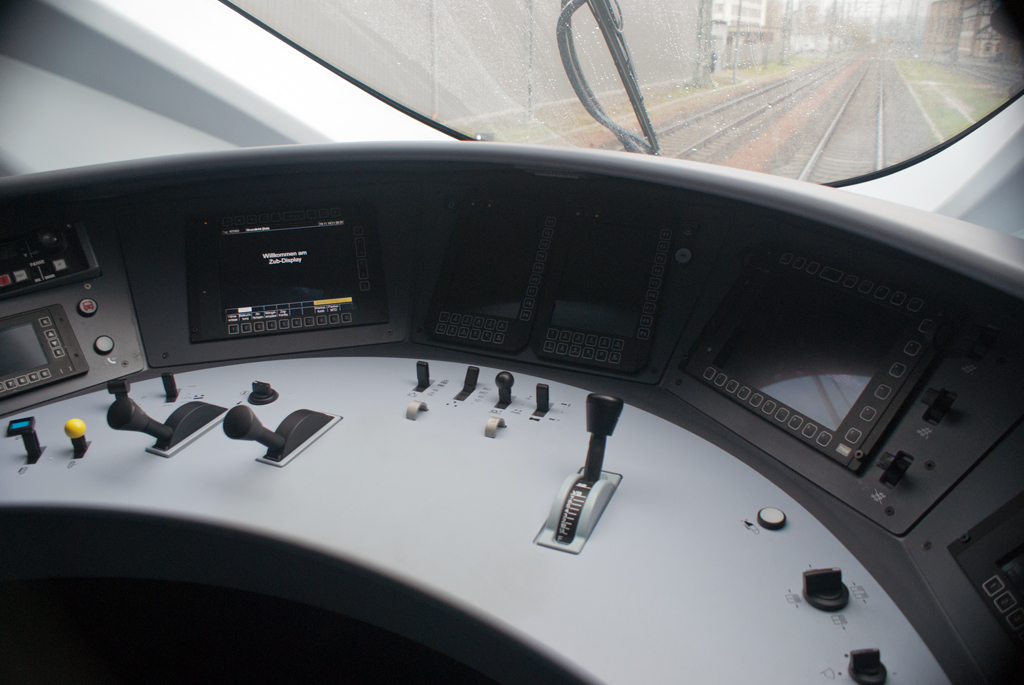
…and the cab, computerised as usual.
High Speed in the 1930s: "Hamburg" type class 137 express DMU
As an intriguing contrast to modern technology, the exhibits present on the workshop grounds also comprised SVT 137 225, normally on display on the "Museum Track" in the east wing of Leipzig Central Station's train shed. Development of high speed railway motive power had reached a very high standard in Germany of the 1930s, though of course, many of these developments were made for reasons of prestige for the Nazi government.
In 1935 and 1936, Deutsche Reichsbahn took delivery of a total of thirteen diesel-electric, articulated express units, designated SVT 137 149 through 152 and 137 224 through 232. These units, built by WUMAG, AEG and Siemens-Schuckert, were 2'Bo'2' configured, with the outer bogies supporting the two 302 kW prime movers. The units were 44 m long, weighed 91 tonnes, offering 2nd class seating (which by post-war standards equalled 1st class standard) for 77 passengers and 160 kph maximum speed.
?137 225 stayed in the Soviet Zone after 1945, and eventually redesigned 183 252. This set was used as a saloon unit for the GDR government and designated a piece of heritage stock in 1975.
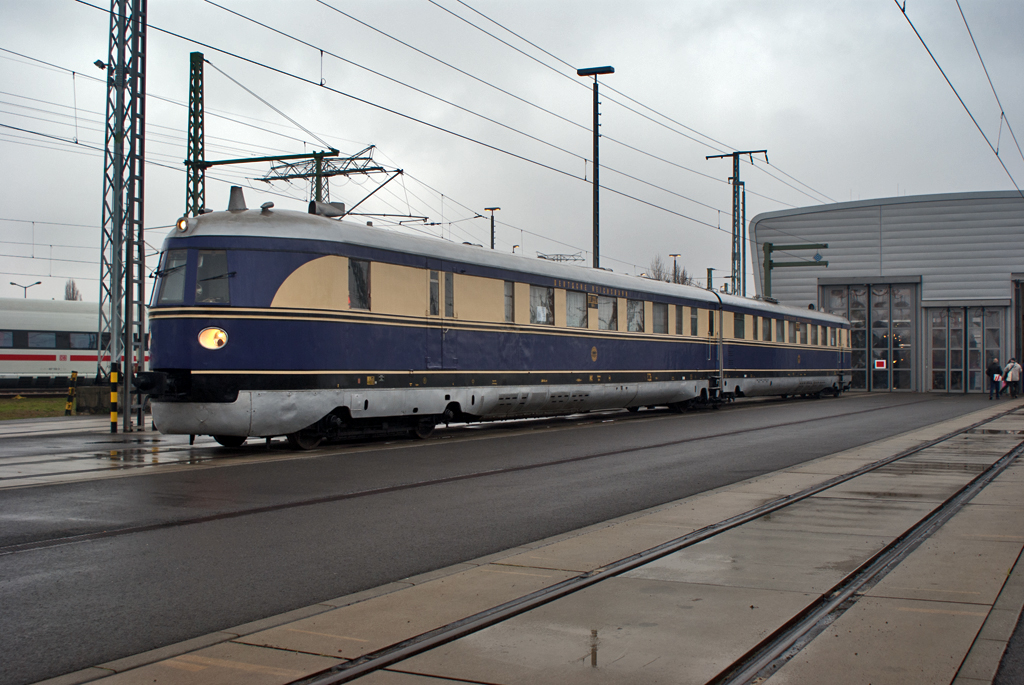
137 225 has been restored to the elegant violet-and-cream 1930s livery and is available for working charter services.
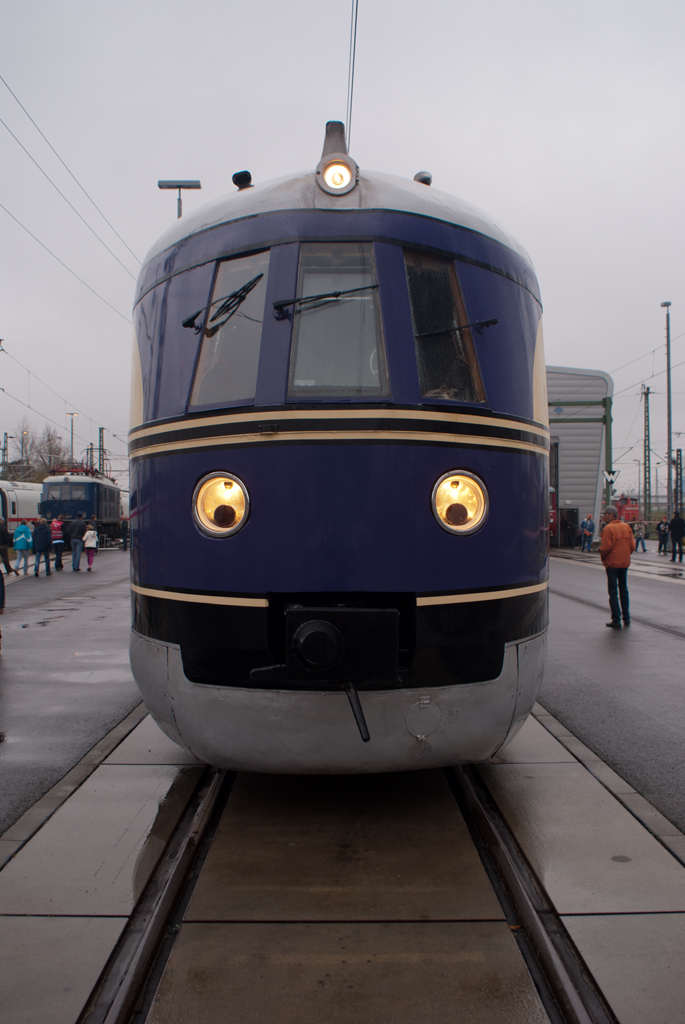
I suppose it should be easily recognisable how this kind of motive power was very well suited for publicity in their time!

However, I rather doubt working conditions for the driver would pass today's H&S standards as the prime mover/generator units protrude well into the cabs…
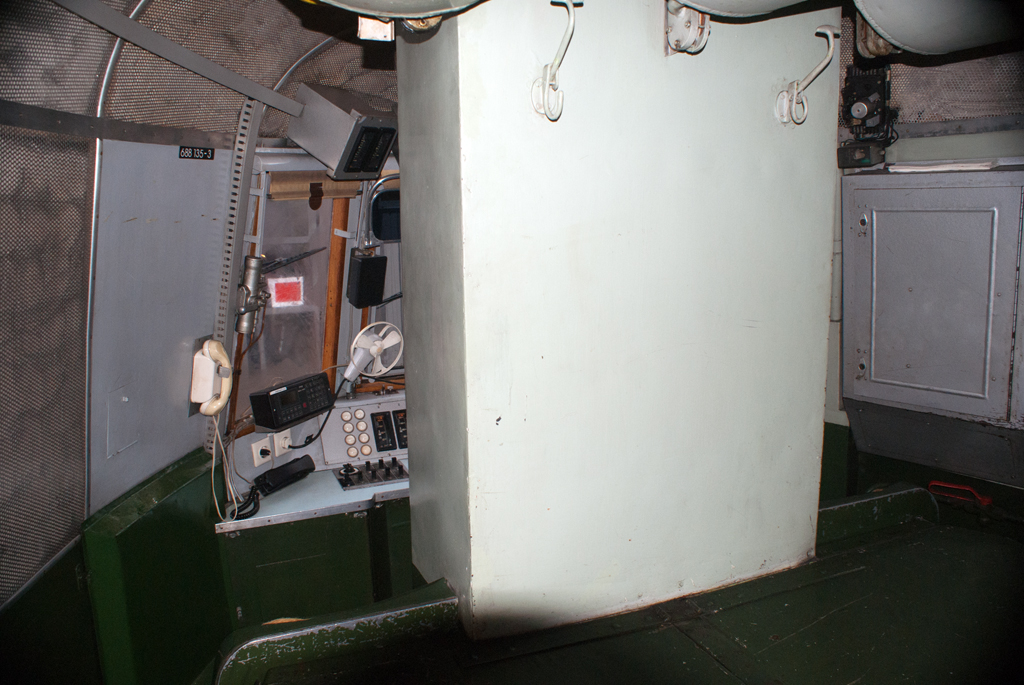
…with the driver's seat being behind this massive pillar.
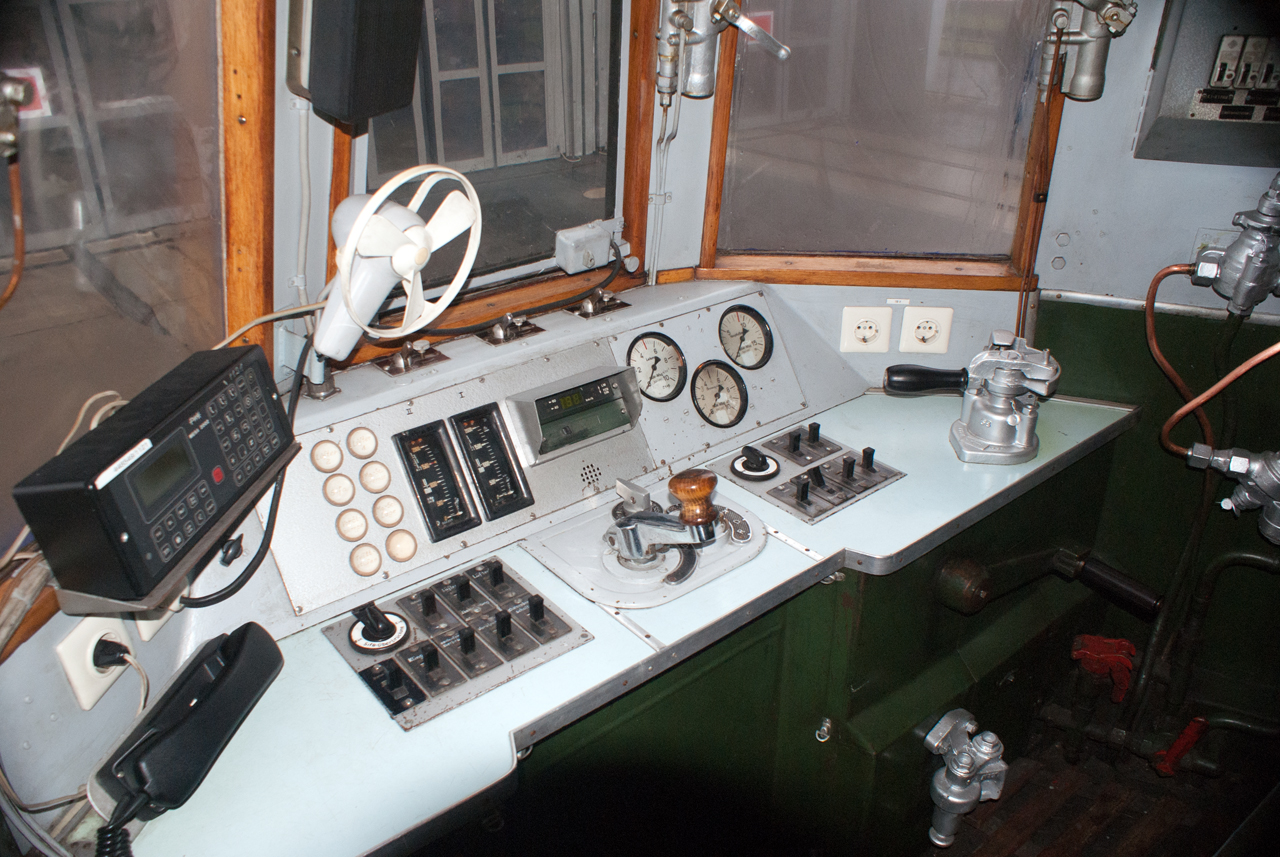
?The control desk needed to be amended with several pieces of contemporary hardware such as a modern-day radio in order to remain operable, but essentially, this is what drivers could expect on these units!

Visibility is largely limited roughly to a 90-degrees arc ahead of the train, considering all three windscreens. I suppose this will well have been sufficient for high speed running in the 1930s!
Electrics Entering Adolescence: E 04 01
?In the 1920s and 1930s, electric traction in Germany evolved rapidly, with the South German and Central German subdivisions of Deutsche Reichsbahn in particular continuing to advance electric operation. As the 1'Do1' configured class E 17 passenger locomotives had been relocated from Central Germany (which historically refers to what is now mostly represented by the states of Saxony and Saxony-Anhalt of our time) in 1929 and 1933 to work the Munich-Stuttgart mainline, Deutsche Reichsbahn contracted AEG for building a batch of locomotives to replace the former Central German E 17s. These locomotives, designated class E 04, closely resembled the E 17 but were somewhat "downsized" to a 1'Co1' configuration.
Twenty-three locomotives, all providing a 2,190 kW one-hour power rating and a maximum speed of 110 kph for E 04 01 through 09 and 130 kph for all remaining locomotives, were built between 1932 and 1935.
?E 04 17 through 22 became property of Deutsche Bundesbahn after World War II, while all remaining locomotives (sans E 04 04 and 13 which had been destroyed by war action) remained in the GDR. E 04 23 was outfitted with push-pull controls and in this role utilised mainly for passenger services between Halle and Leipzig from 1958 till 1966.
Four locomotives have been preserved, with E 04 01 having been an official Deutsche Reichsbahn heritage locomotive.

The E 04 – 104 for Deutsche Bundesbahn, 204 for Deutsche Reichsbahn following the introduction of computerised running numbers – has long been among my favourite locomotives, so seeing E 04 01 outside the museum track at Leipzig Central Station was especially delightful. Her livery is the standard 1950s/1960s Deutsche Reichsbahn scheme for electric locomotives. She was outfitted with RBS 58 diamond pantographs during her GDR career. Also note the asymmetrically spaced driving wheelsets, of which two are set on the Cab 1 end and one is closer to Cab 2.
Watch how the cabs are designated "V" (vorn) for Cab 1, and "H" (hinten) for Cab 2, which had been customary since before World War II.

E 04 01 is indicated by this plaque to have the works number 4681, and to be 82 years old. Amazingly, the last West German 104s were retired only in 1982.

The traverse for the right hand Indusi transceiver, which is hung between the second and third set of driving wheels. Interestingly, the locomotive is even lettered with an EVN-formatted running number.
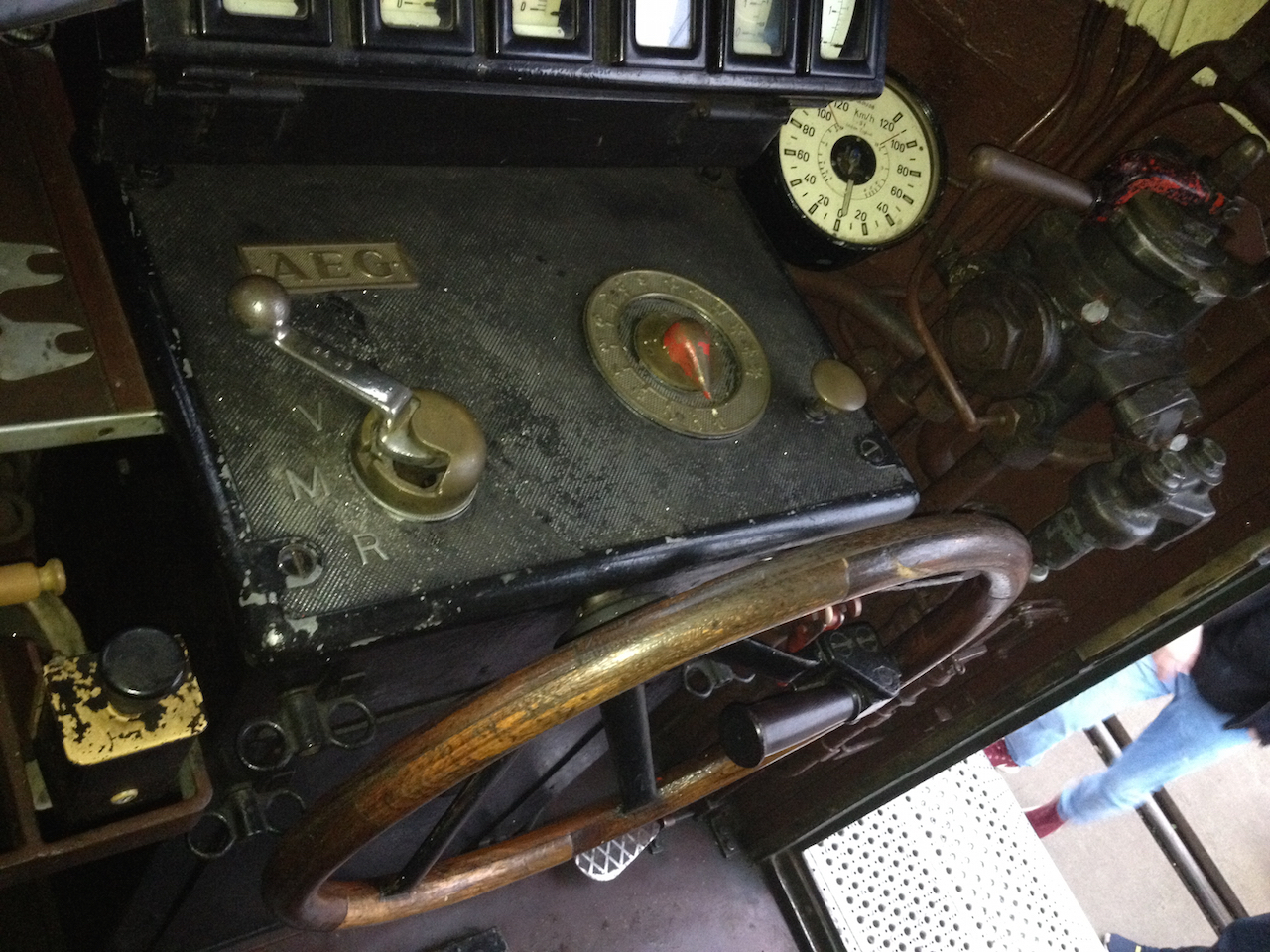
In a sharp difference to today's standards, the E 04 was not yet designed for the driver to work seated (though it did become common practice to at least provide simple folding chairs on such motive power in the post-war era). Compared with modern motive power, I suppose the control desk can also be considered simplistic, with the large power controller wheel being attached vertically. As the tap changers on these early electrics were not power-assisted, large controller wheels provided sufficient leverage to limit the effort required for operating them.
?As you can see from the simple "arrowhead" indicator, the E 04 had fifteen power notches. Also note the speedometer to the right, which interestingly has separate scales for both running directions.
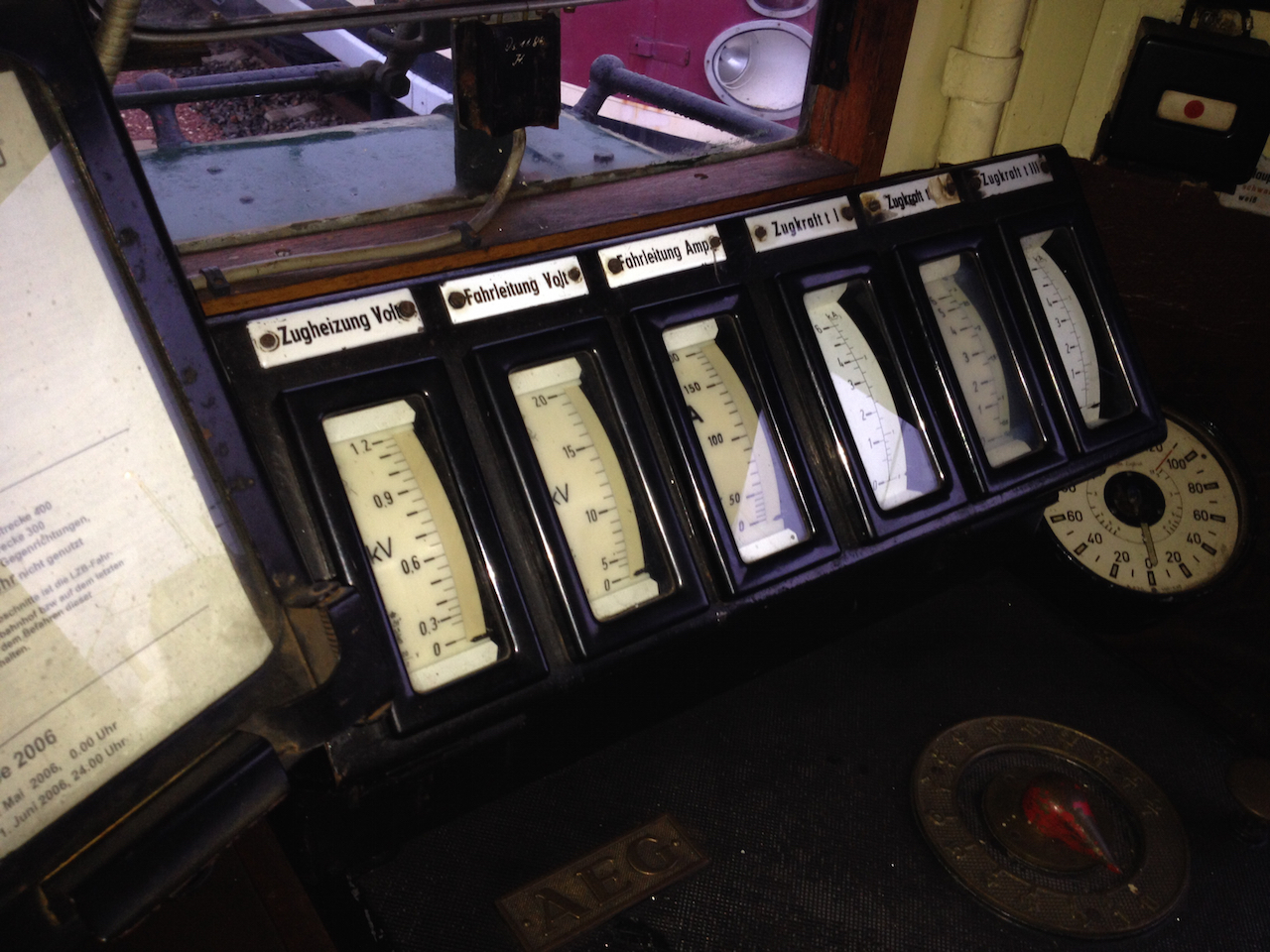
Voltmeters and ammeters for ETS, OHLE, and each of the three traction motors. Note that the line ammeter ends at 200 A, so the maximum permissible current draw on this class will have been fairly restricted!
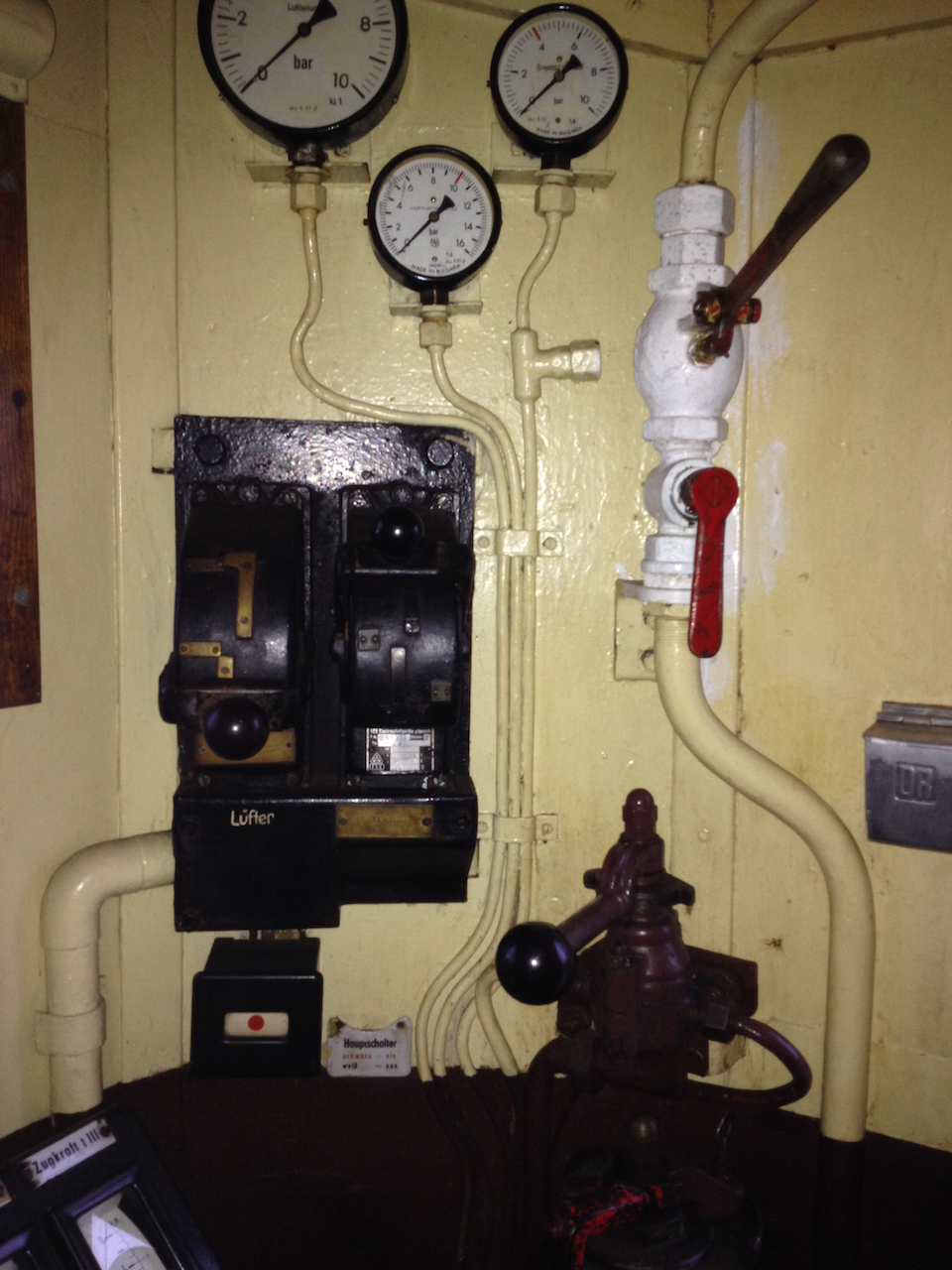
?Switches for blowers and compressor, as well as brake pressure gauges, on the right hand pillar.
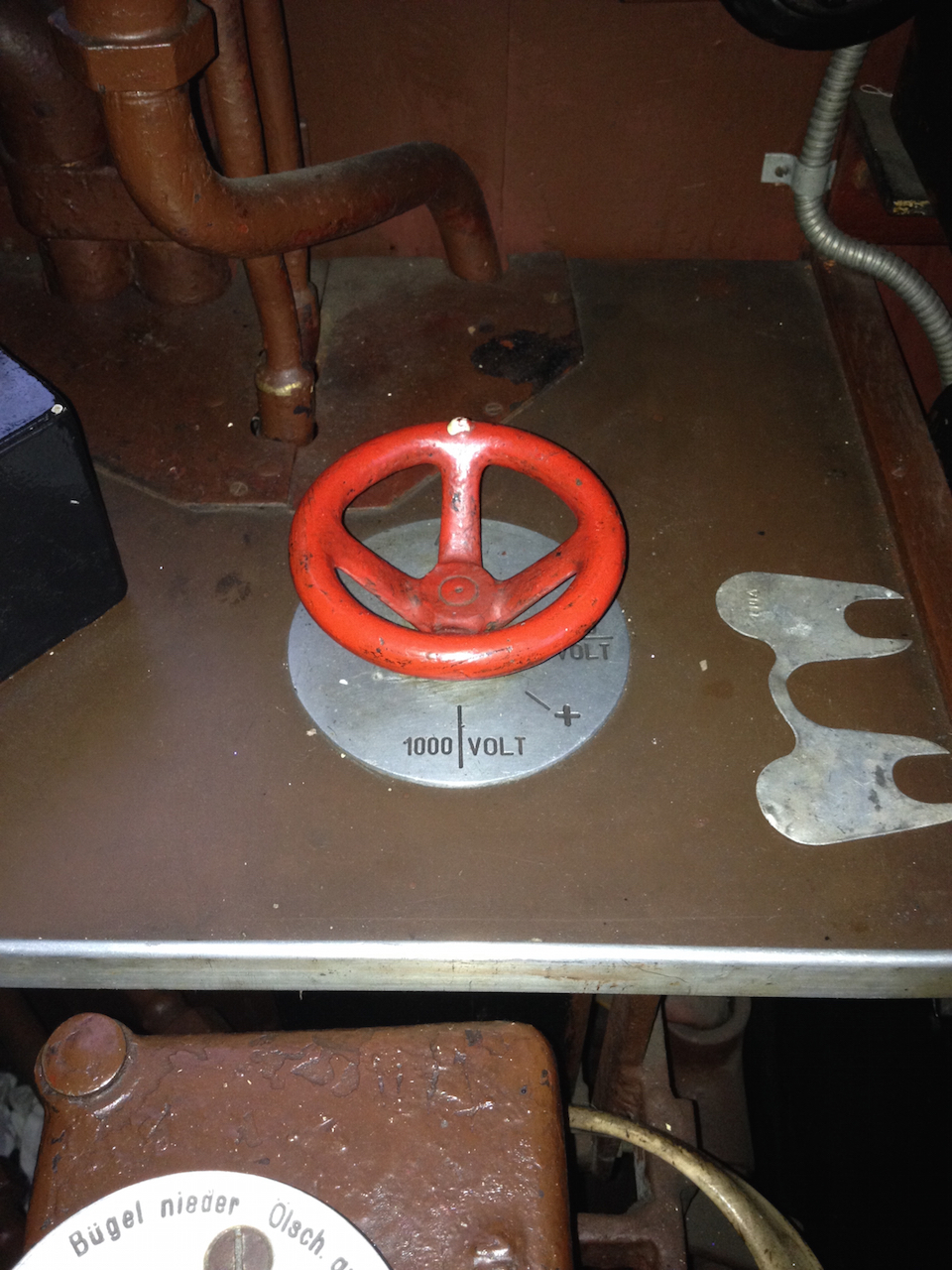
In Continental Europe, ETS parameters were standardised to 1,000 V AC only well after World War II. No longer required after all German coaching stock had been thus standardised, this ETS voltage selector switch (also present on other contemporary locomotives) was no longer required and eventually disabled.

Awaiting the route (I wish!).
The Queen of Pre-War Electrics: E 18 047
Intending to obtain an electric locomotive capable of speeds in excess of 130 kph, Deutsche Reichsbahn followed up their order for the E 04 with one for an evolved, 1'Do1' configured locomotive which was to combine the E 17's basic configuration with the electrical layout already present on the E 04. This resulted in what many consider the best German electric passenger locomotive to be developed prior to the disaster that was World War II.
Designated class E 18 – subsequently, 118 for Deutsche Bundesbahn and 218 for Deutsche Reichsbahn – , fifty-three of these sturdy locomotives were built from 1935 till 1939. Furthermore, E 18 054 and 055 were assembled from prefabricated but unused components in West Germany, bringing the total number to 55. The last Deutsche Bundesbahn 118s were retired in 1984. The locomotives provided a one-hour power output of 3,040 kW and maximum speed of 150 kph.
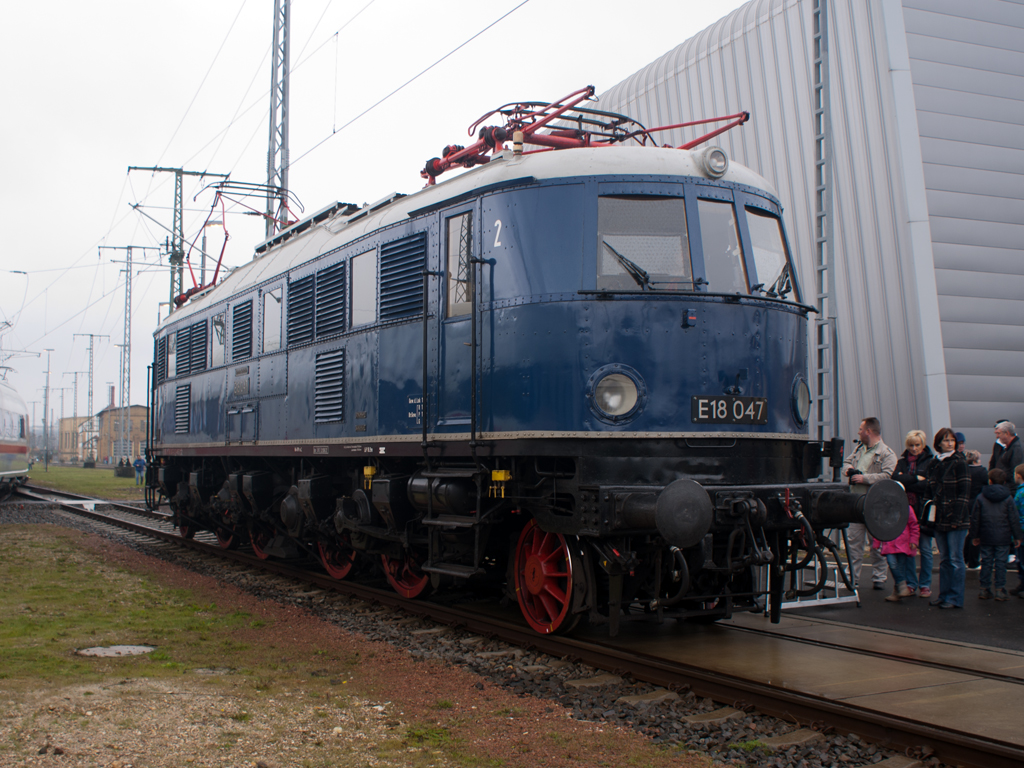
Also one of my favourite historic locomotives, this class was represented by E 18 047 as owned and operated by DB Museum. The locomotive has been restored to her 1950s/1960s Deutsche Bundesbahn appearance with cobalt blue body, black chassis and red wheelsets, and leaves a rather striking impression.

?One of the last E 18s to have been built, E 18 047 has the works number 5161 and was rolled out in the fateful year the lights went out all over the world.
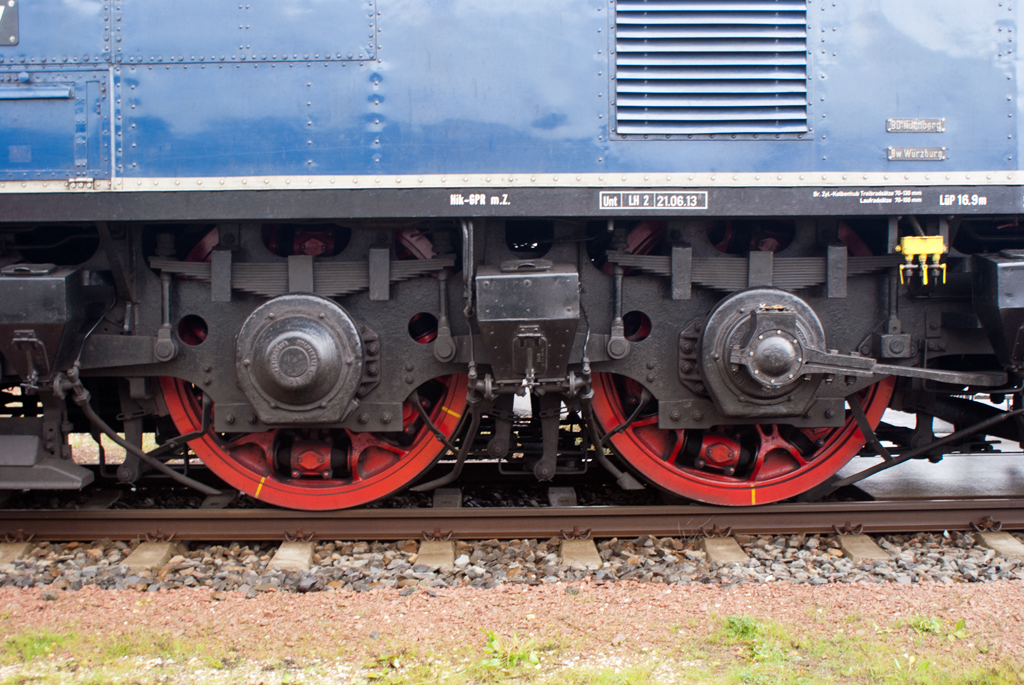
Much like the E 04 and E 17, the E 18 had double sided quill drives with spring pots attaching bilaterally to the driving wheel spokes. The outermost driving wheelsets and the carrying wheels were combined to form AEG-Kleinow bogies for better curve running abilities.
?The locomotive is lettered to be equipped with a Hildebrandt-Knorr brake controller (Hik) with settings G, P and R and direct shunting brake (mZ). The E 18 did not have any dynamic brake. E 18 047 is dated to have had her last revision completed on 21 June, 2013, in Halle.

Also similar to the E 04, the Indusi transceivers were attached midway down the locomotives' length – between the second and third set of drivers.

All wheelsets on the E 18 were outfitted with double-sided tread brakes to obtain sufficient braking performance for the design speed of 150 kph. The E 19s – a batch of four evolved 1'Do1' electrics based on and very similar to the E 18 – were even capable of 180 kph.
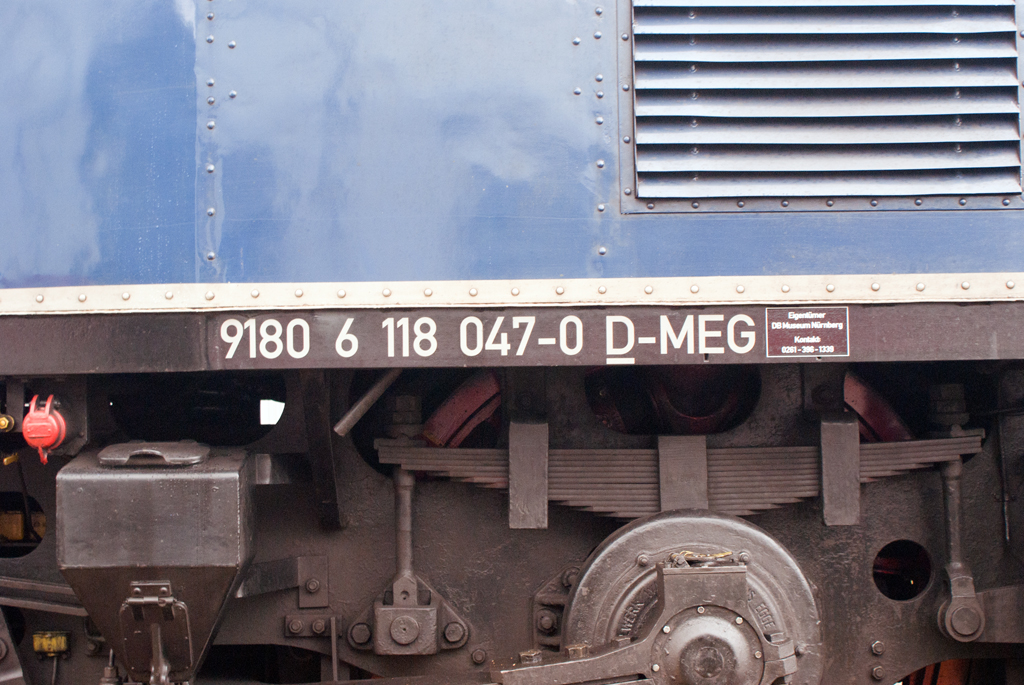
Interestingly, actual operation of E 18 047 has been outsourced to Deutsche Bahn subsidiary Mitteldeutsche Eisenbahn, as indicated by the EVN number on the solebar.
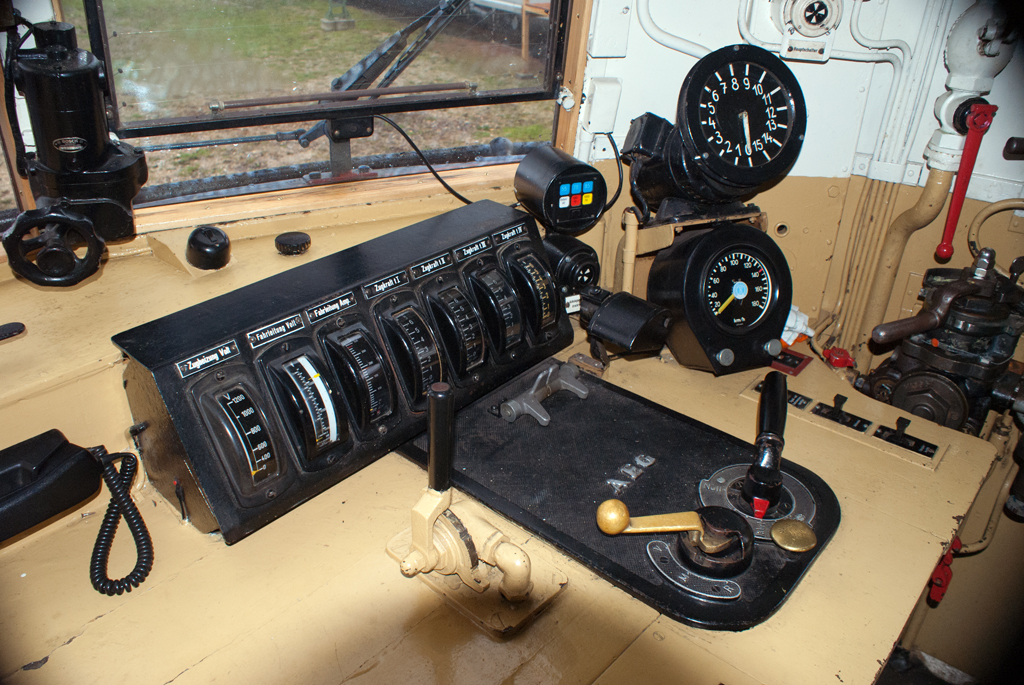
It's intriguing to remember that all this has once been cutting edge technology! The E 18 also pioneered cabs configured for the driver to work seated, as it had been determined that forcing drivers to work standing at the high speeds permitted by the new generation of electric locomotives would be too risky.
?The E 18 was also outfitted with an impulse power controller, actuated by the right of the two levers seen in this photo. The brass lever left of it is the reverser handle. This means that the tap changer itself is motor-actuated, also contributing to a tremendous work relief for the driver.
As on the E 04, the array of indicators ahead of the power controller are for the ETS circuit; OHLE voltage and current; and operating current for each of the four traction motors – though the latter are actually designated "tractive effort."
Also note the large tap changer notch indicator atop the speedometer, and the indicator cluster for the locomotive's PZB suite between these and the electrical indicators. As heritage stock must be outfitted with the latest standards in train protection and communications equipment, E 18 047 is operating with the same PZB 90 software as revenue-earning motive power. The locomotive's radio is just off screen in this view, inserted into the broadside of the left half of the control desk.
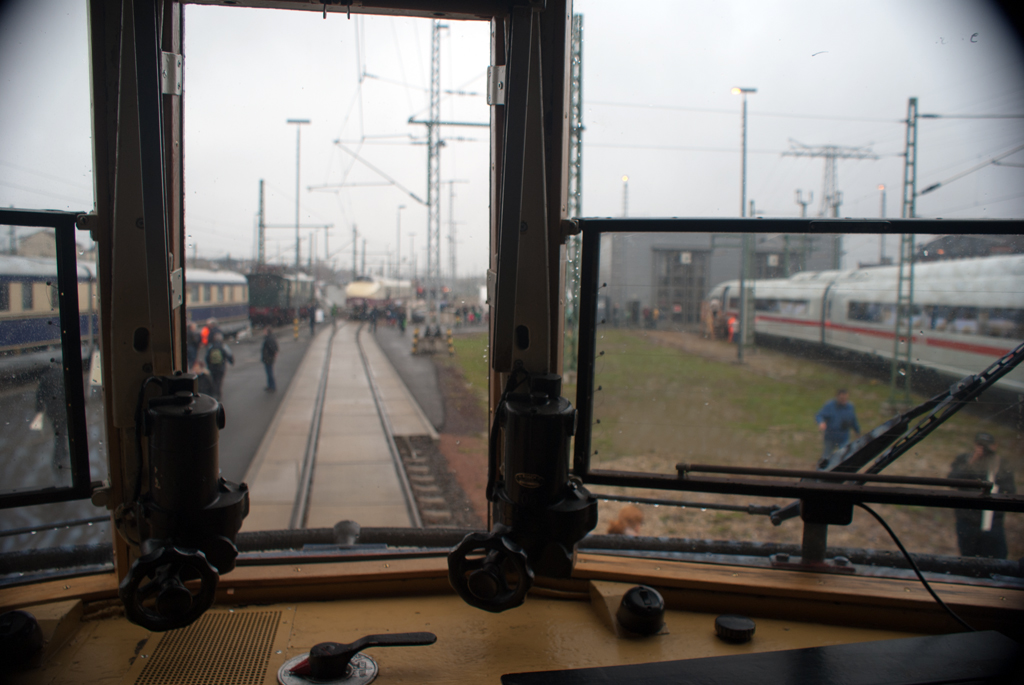
In my impression, visibility from the cab is actually quite good.
-
 2
2




0 Comments
Recommended Comments
There are no comments to display.
Create an account or sign in to comment
You need to be a member in order to leave a comment
Create an account
Sign up for a new account in our community. It's easy!
Register a new accountSign in
Already have an account? Sign in here.
Sign In Now